Galapagos Islands are a dream destination for animal and nature lovers. The large variety of animals, plants and landscapes that are spread across the many islands make it a favourite destination for most visitors.
There are many different ways to visit the Galapagos, depending on your time and interests. You can stay on one or two islands and take day trips to nearby islands. Or take a multi-day cruise which allows you to see more islands with a larger variety of landscapes and animals. There are also live-aboard dive ships. We did a little of each. We went on a 5-day/6-night cruise where we began and ended on different islands. From these two islands we went on one-day dive trips. This allowed us to experience many different parts of the Galapagos.
Galapagos is an archipelago of 127 volcanic islands and islets 1,000km off the coast of Ecuador. This isolated location has resulted in a large amount of endemic plants and animals. Some islands even have their own endemic species specific to that island. Because of this diversity, Charles Darwin was able to go from island to island and compare how the unique differences in the species allowed them to survive and thrive in different environs.
The landscapes are very interesting and surprisingly different. Some islands are covered in solidified lava. These islands have plants and animals that have adapted to the different ground. One is the lava cactus which can be seen poking through cracks in the hardened lava. Small lava lizards quickly scurry between these cracks searching for food. In many areas, the lava has eroded resulting in interesting patterns, some that look like works of art with bright colours and unusual designs.
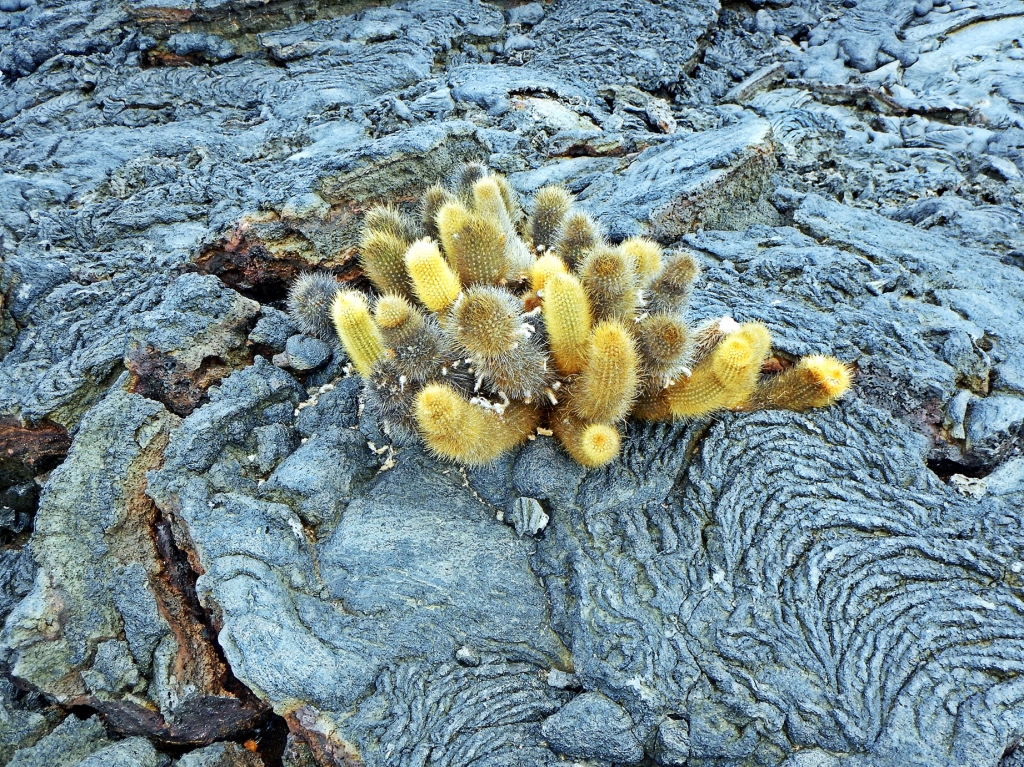
Lava cactus in dried lava, Galapagos 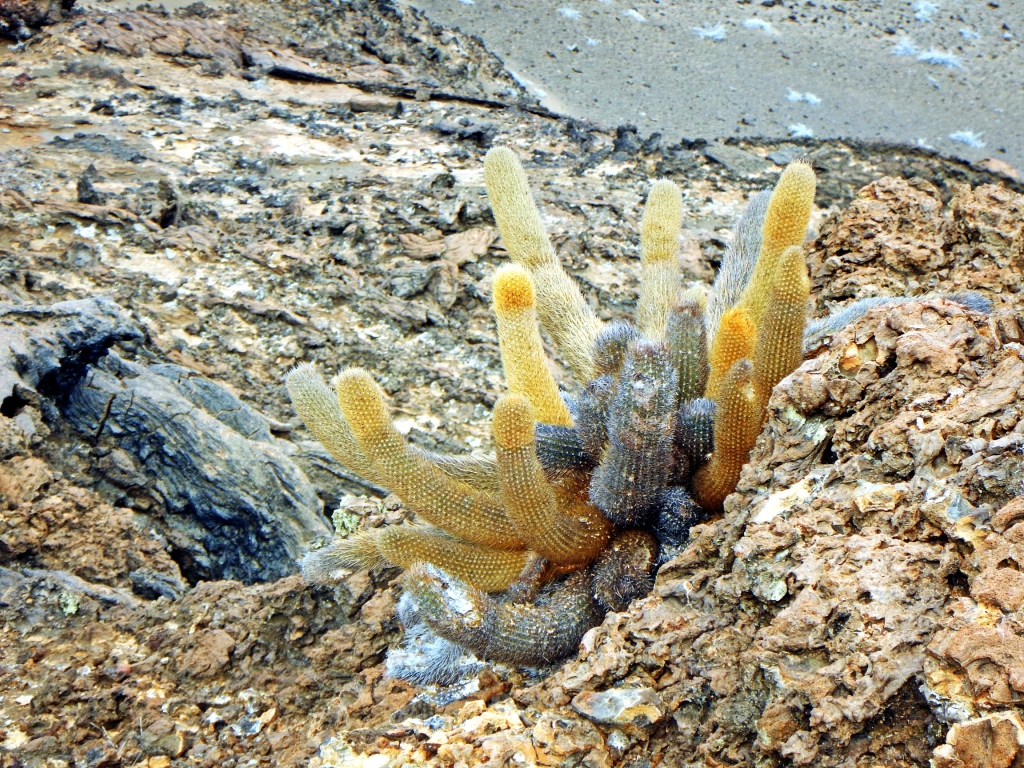
Lava Cactus, Galapagos 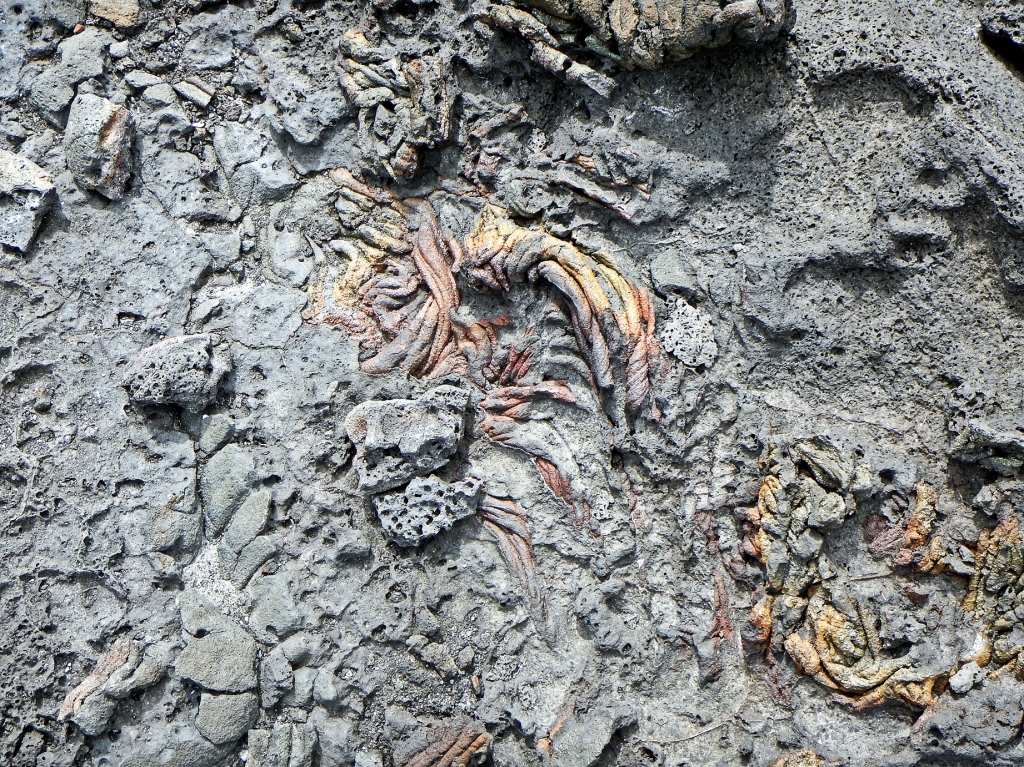
Colourful lava formations, Galapagos 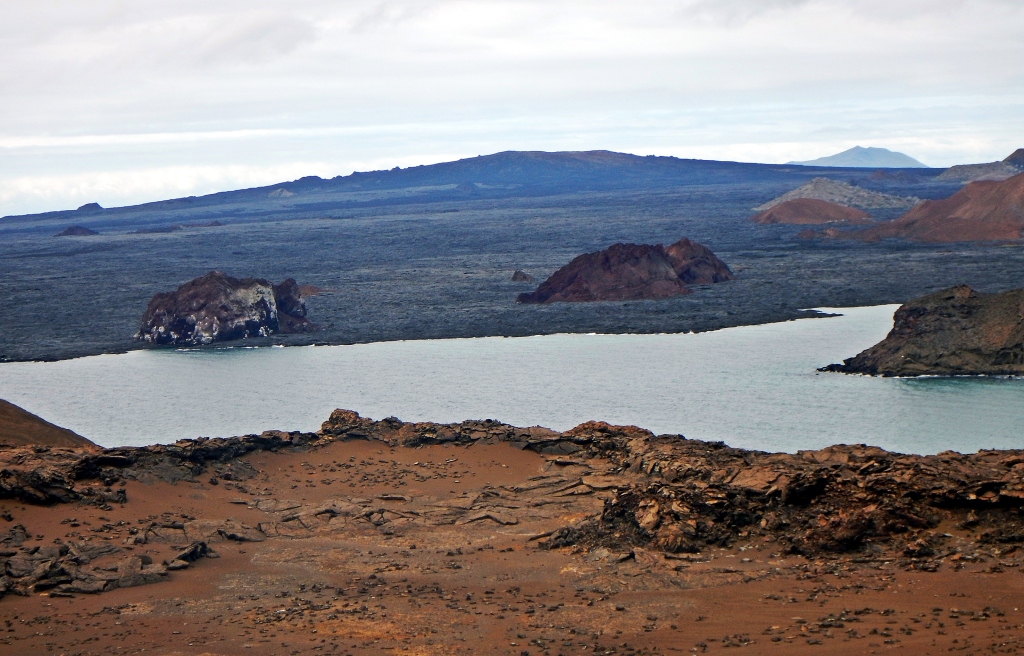
Lava landscape, Galapagos
Other islands are not volcanic, but were formed by geological seismic uplifts. These islands often have bright red earth and dramatic rocky cliffs which provide refuge for many birds. The vegetation is also different. We saw many Opuntia Cactus, a type of prickly pear, that is endemic to Galapagos. Another interesting plant was the bright red ground cover called Galapagos Common Carpet Weed. It added lovely colour to our pictures. There were many of the aromatic Palo Santo trees. Its wood is burned as incense or used to make an essential oil. When we were there these trees were without leaves making them appear very ominous.
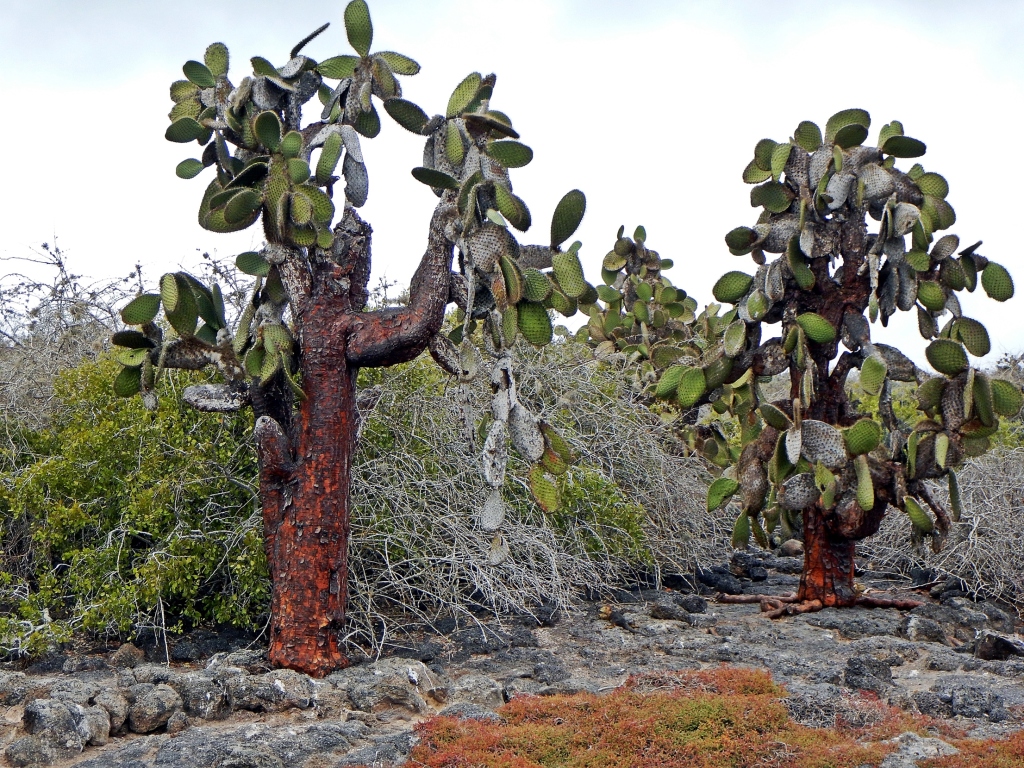
Prickly pear cactus forest, Galapagos 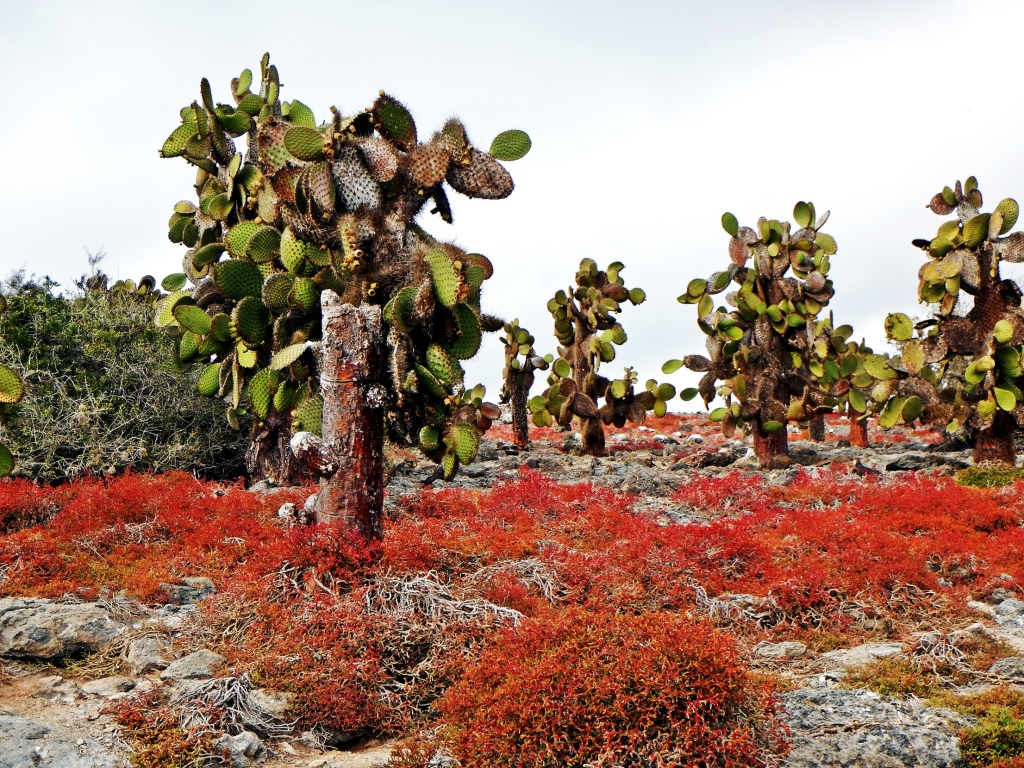
Prickly pear cactus forest and Galapagos common carpet weed 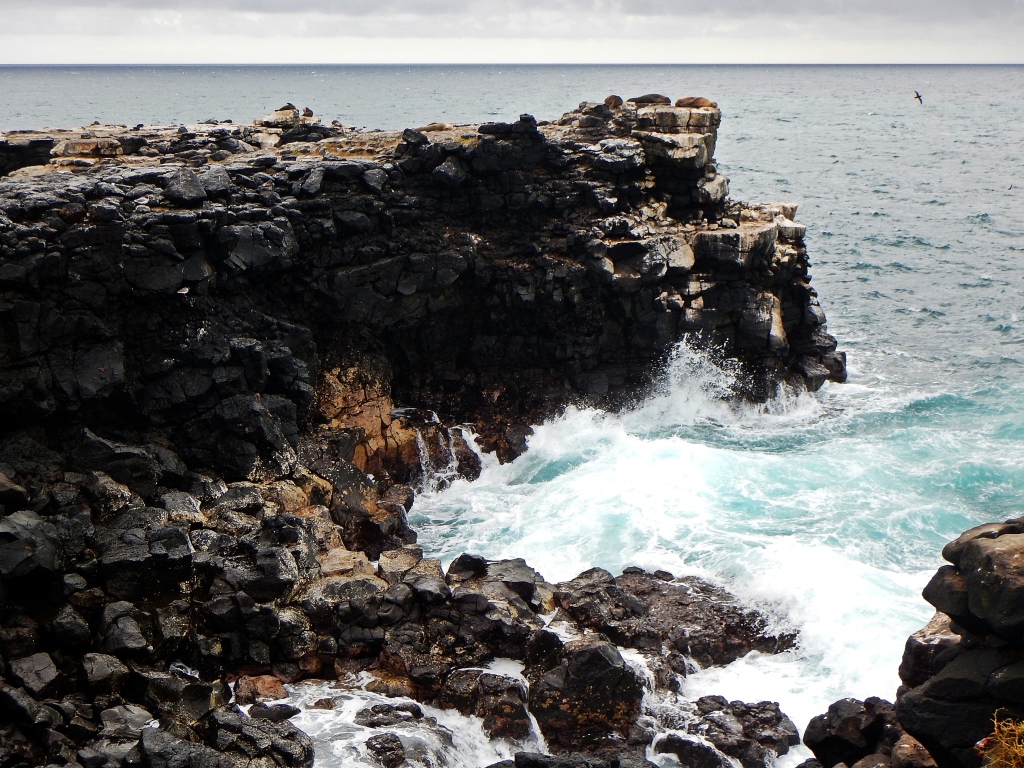
Rocky coastline, Galapagos 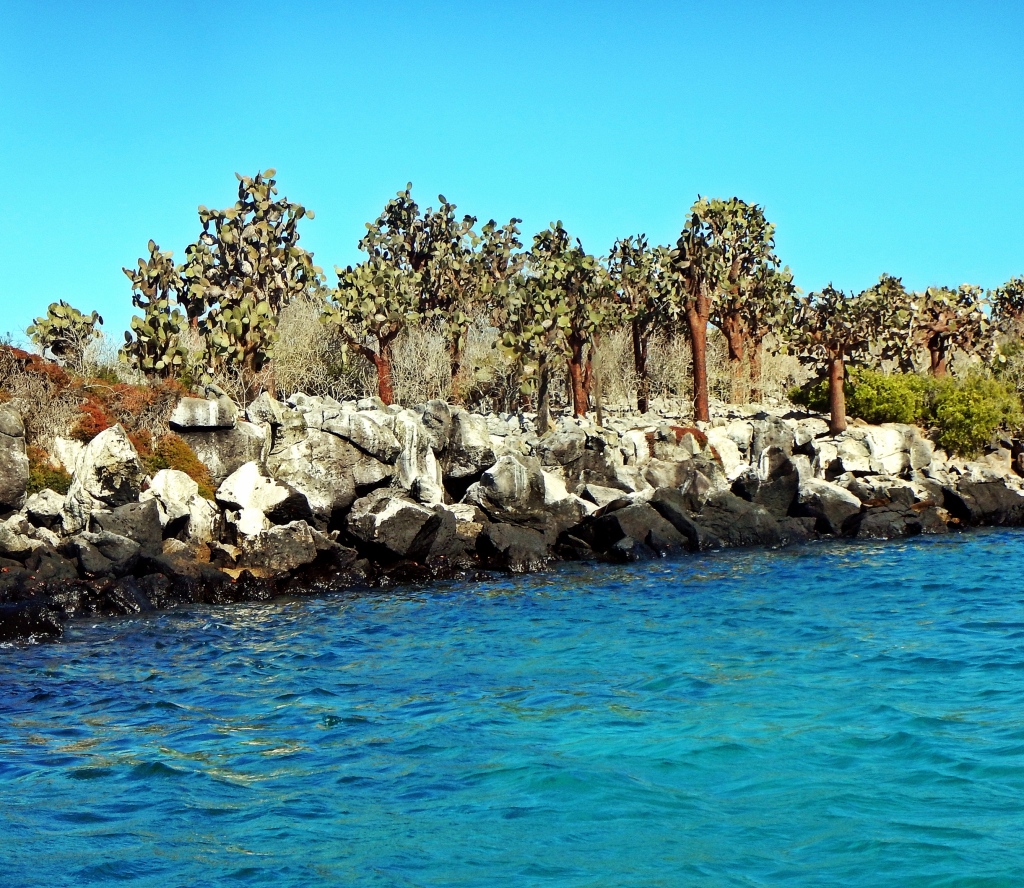
Rugged coastline, Galapagos 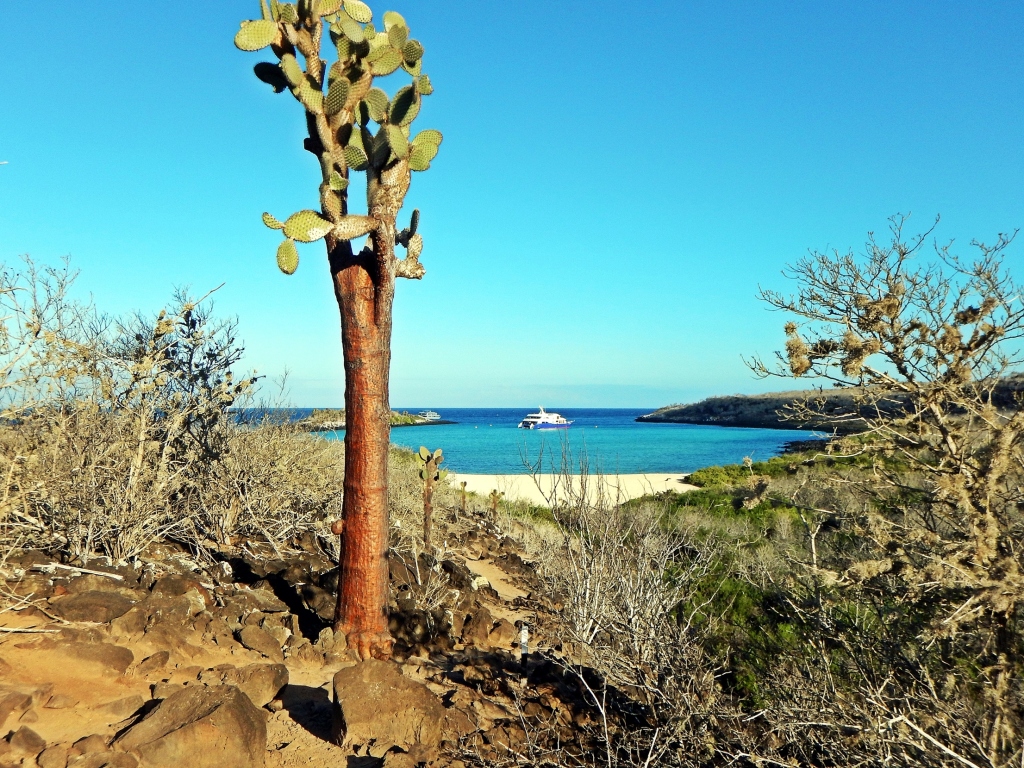
Yacht in a Galapagos cove and a prickly pear cactus 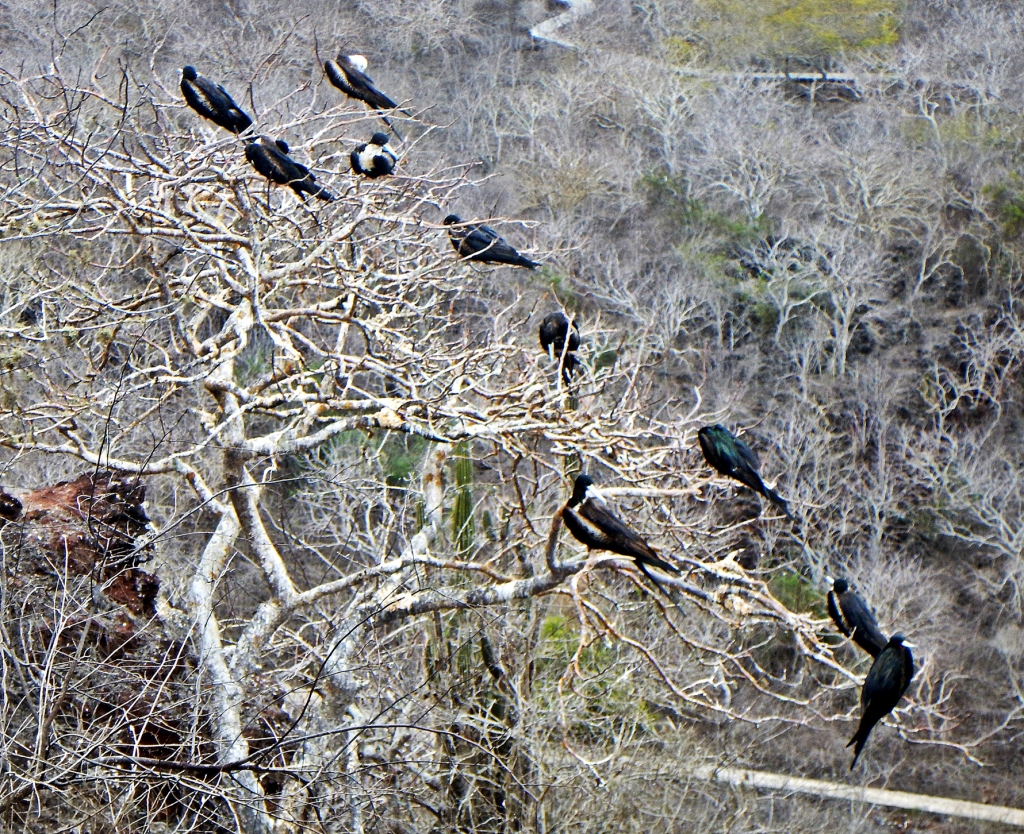
Flock of birds on a palo santo tree, Galapagos 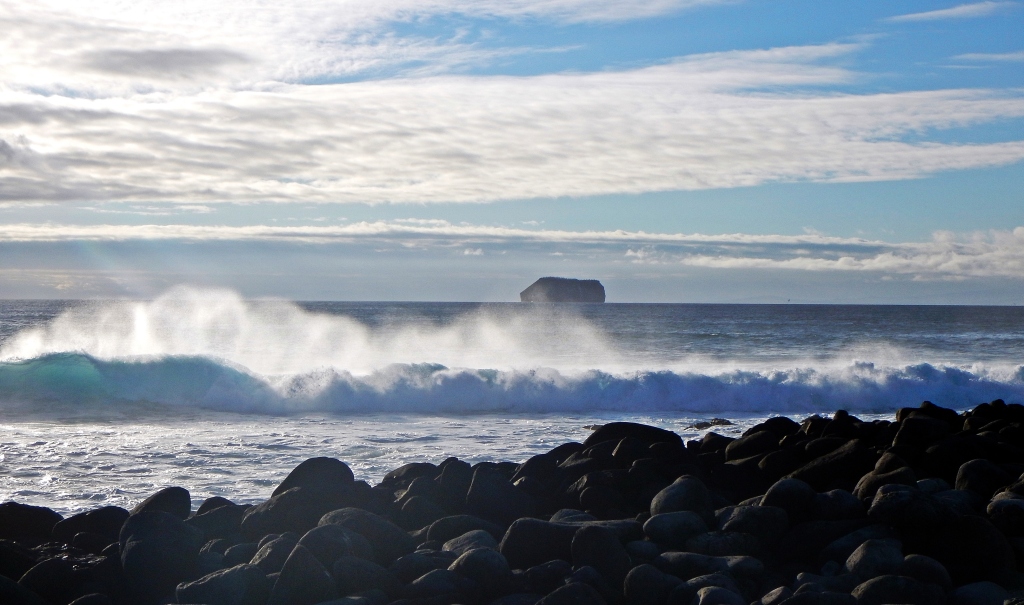
A Galapagos Island coastline
The capital city of Puerto Ayora is on Santa Cruz Island. The fish market in town looked like a usual fish market in South America, until we saw it from behind. There were dozens of sea lions and pelicans loudly begging for scraps. This must be a frequent occurrence because the market staff didn’t even flinch. They just tossed the unwanted parts of the fish over their shoulders to the waiting crowd.
On the other side of Santa Cruz is a remarkable lava tunnel. The tunnel is 1 km long and was formed when one layer of molten-lava solidified but the lava below kept going. This left an empty shell of lava with an inner empty core. We went through the tunnel from one end to the other. Mostly we could walk upright, but at times it was so shallow that we had to crawl. The inside of the tunnel was surprisingly smooth and looked hand-made rather than formed by a river of lava. It was very bizarre to be inside this formation.
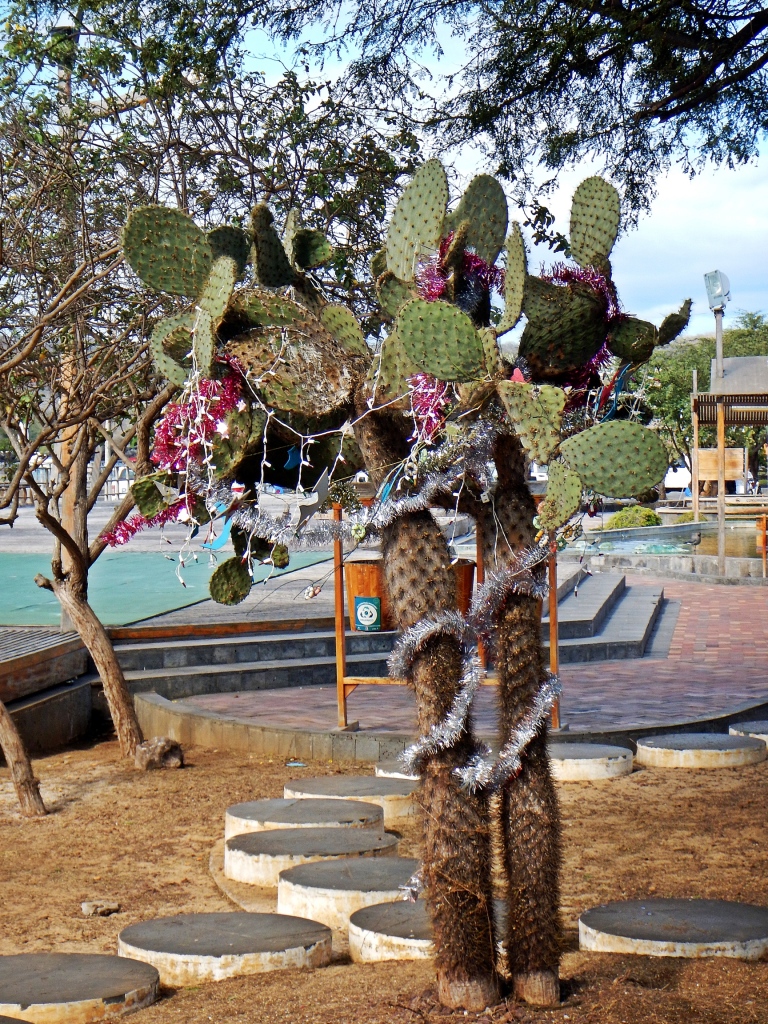
Galapagos Christmas tree 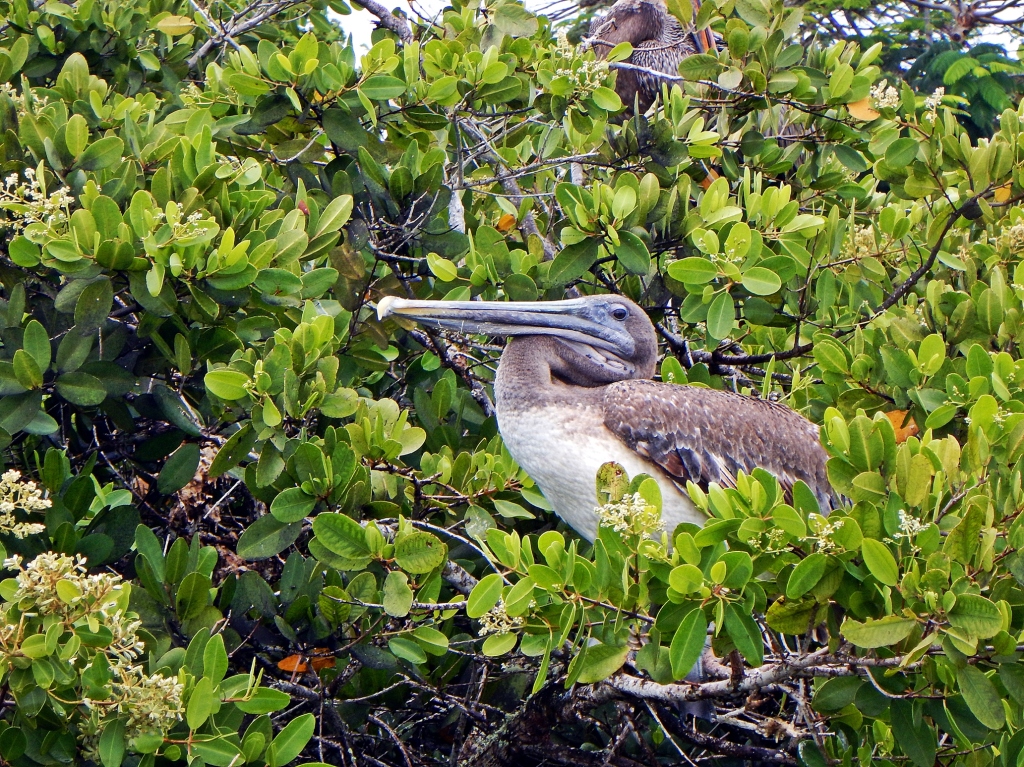
Brown Pelican, Puerto Ayora, Galapagos 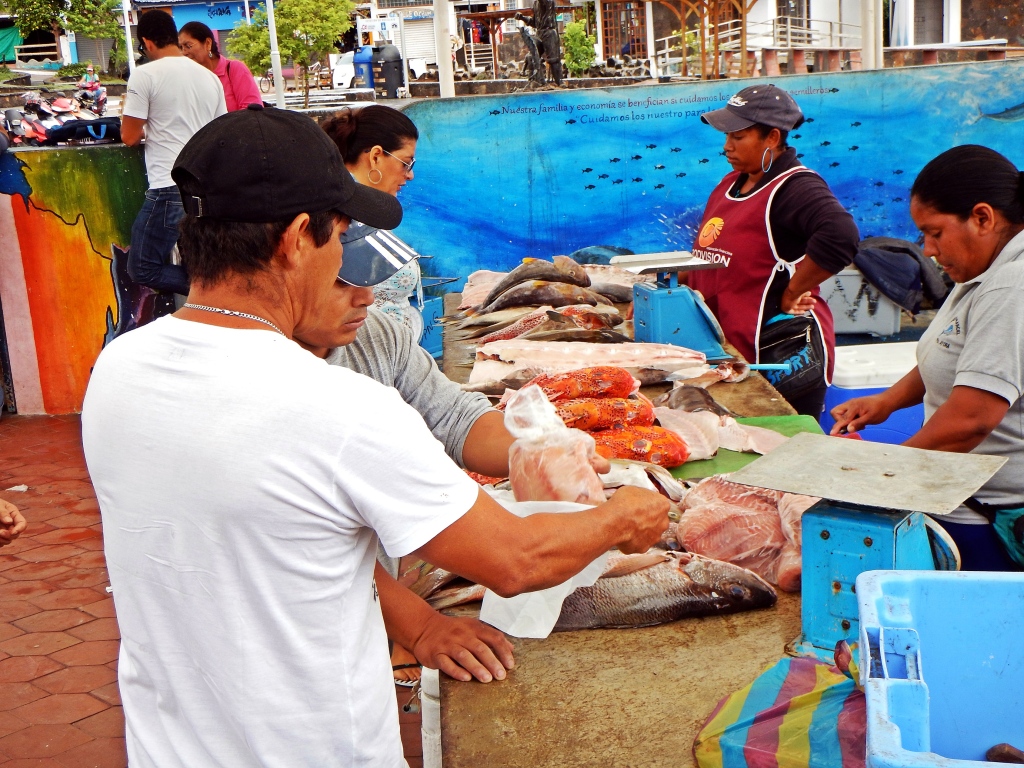
Fish market in Puerto Ayora, Galapagos 
Beggars at the fish market in Puerto Ayora, Galapagos 
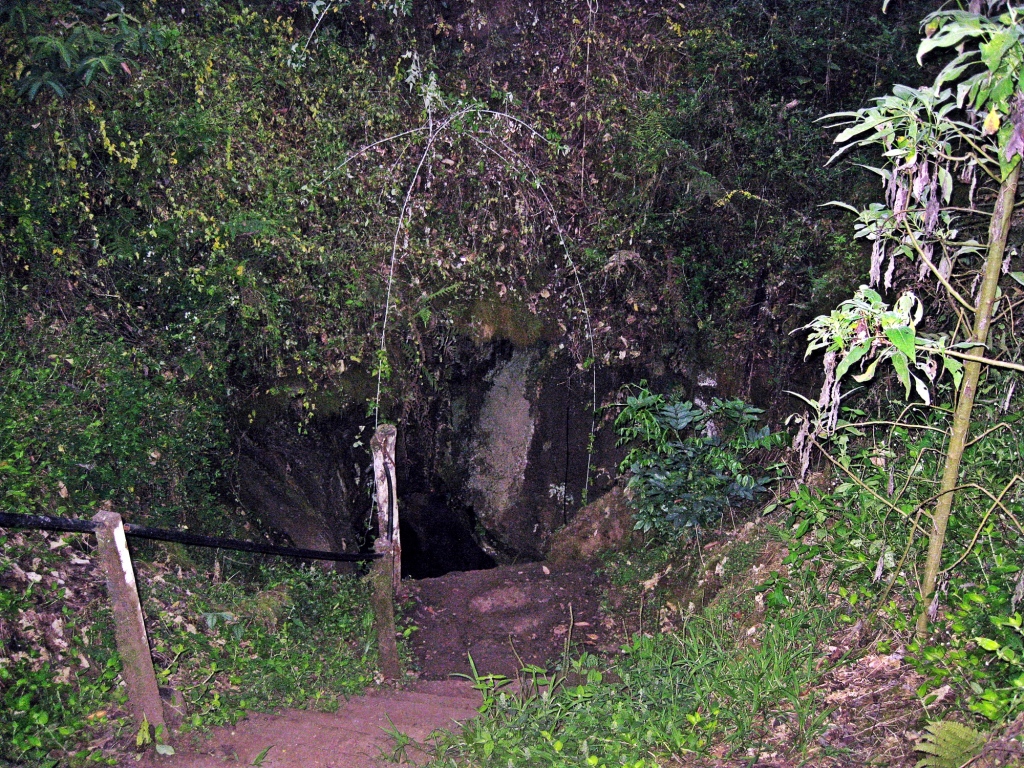
Lava tunnel, Galapagos
Bartoleme Island has one of the most iconic images of the Galapagos with the Rock Pinnacle. The rock was formed by an underwater exploding volcano. The island’s viewpoint above gives an awesome view of the pinnacle, the island’s beaches and the surrounding islands.
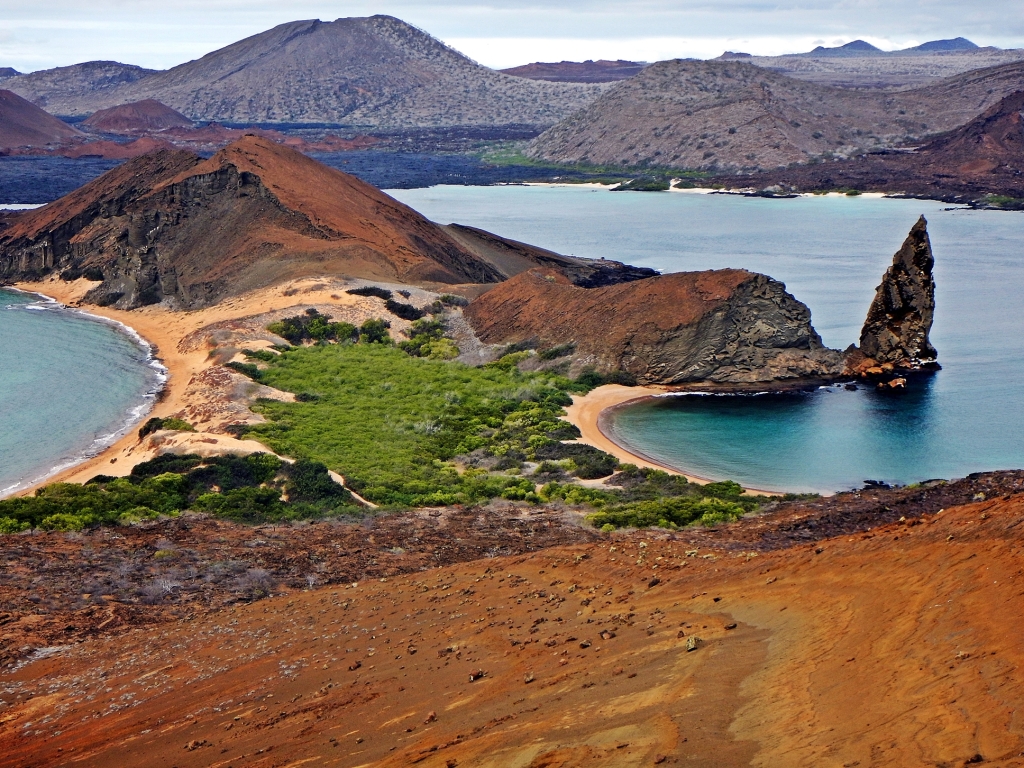
Pinnacle Rock, Bartolome Island, Galapagos 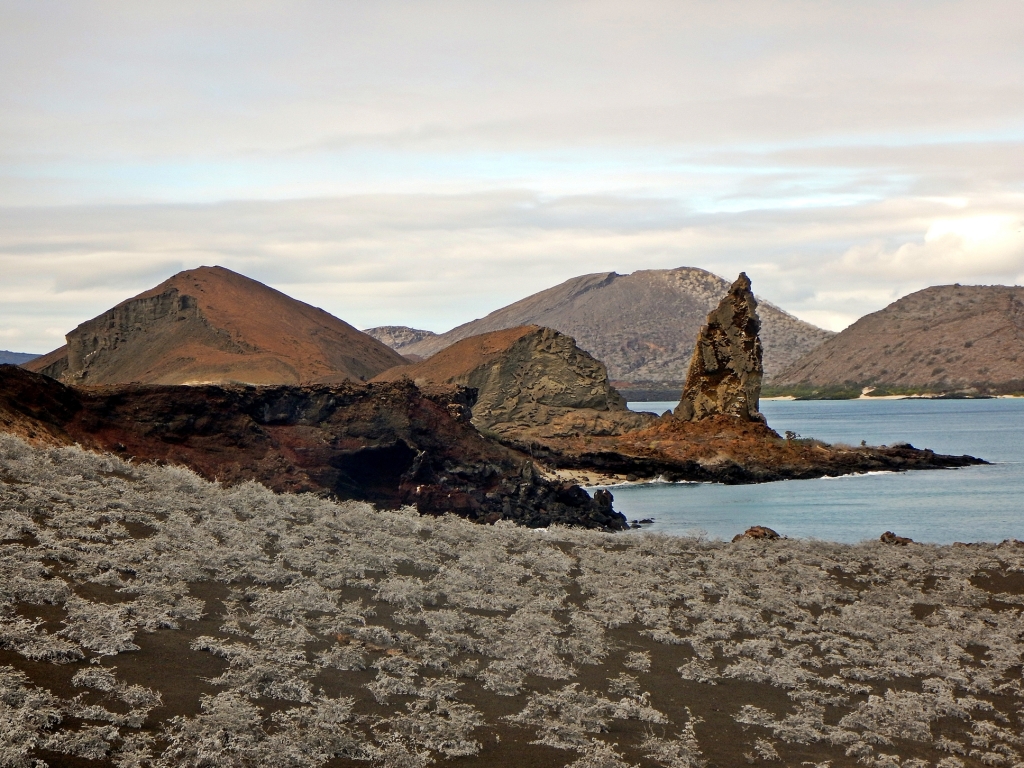
Pinnacle Rock, Bartolome Island, Galapagos 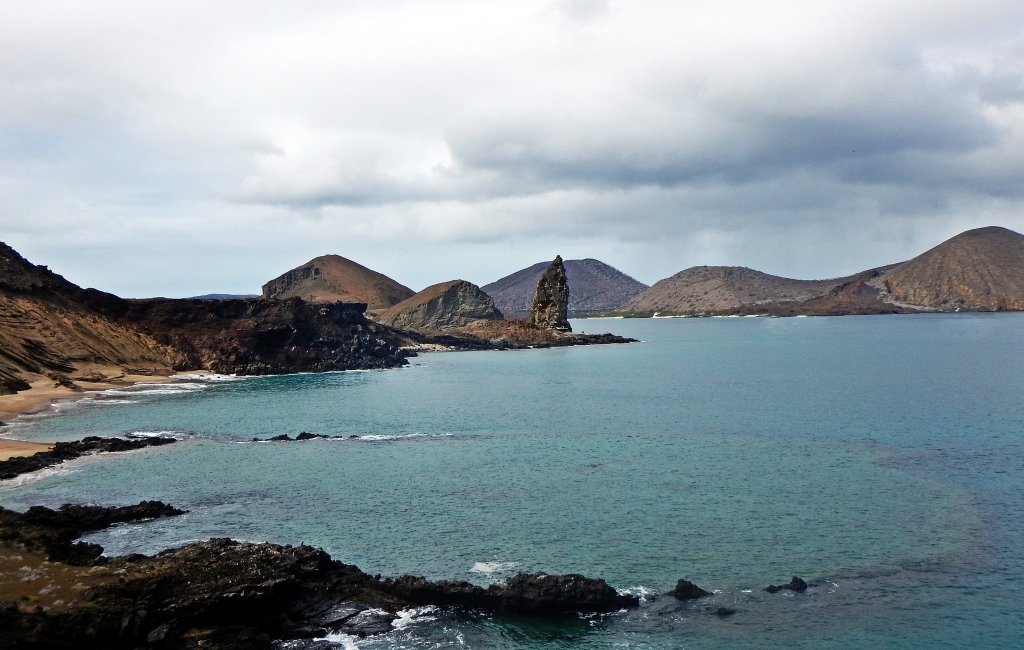
Pinnacle Rock, Bartolome Island, Galapagos
There are many usual animals and reptiles on the islands including the three types of iguanas. There are dark black marine iguanas that spend most of their time in the ocean. There is also the yellow coloured land iguanas. In areas where these two iguanas can meet, there are the unusual hybrid iguanas. These are born from male marine and a female land iguanas. The hybrids always have light colouring on their neck, but otherwise may take on characteristics from either.
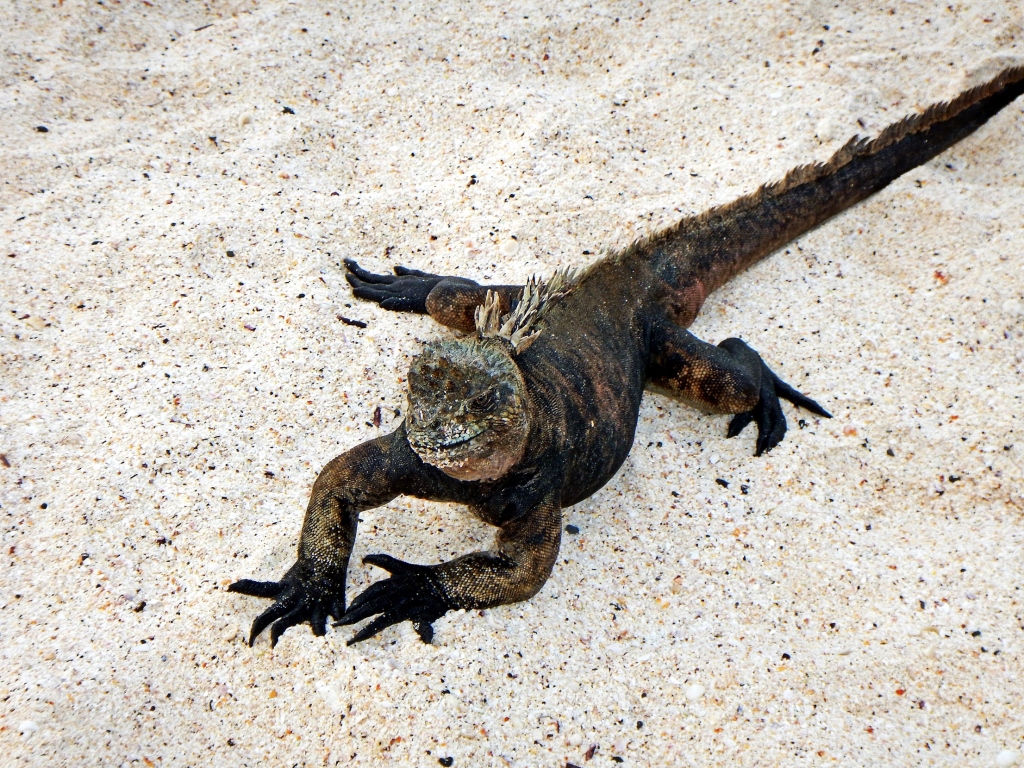
Marine Iguana, Galapagos 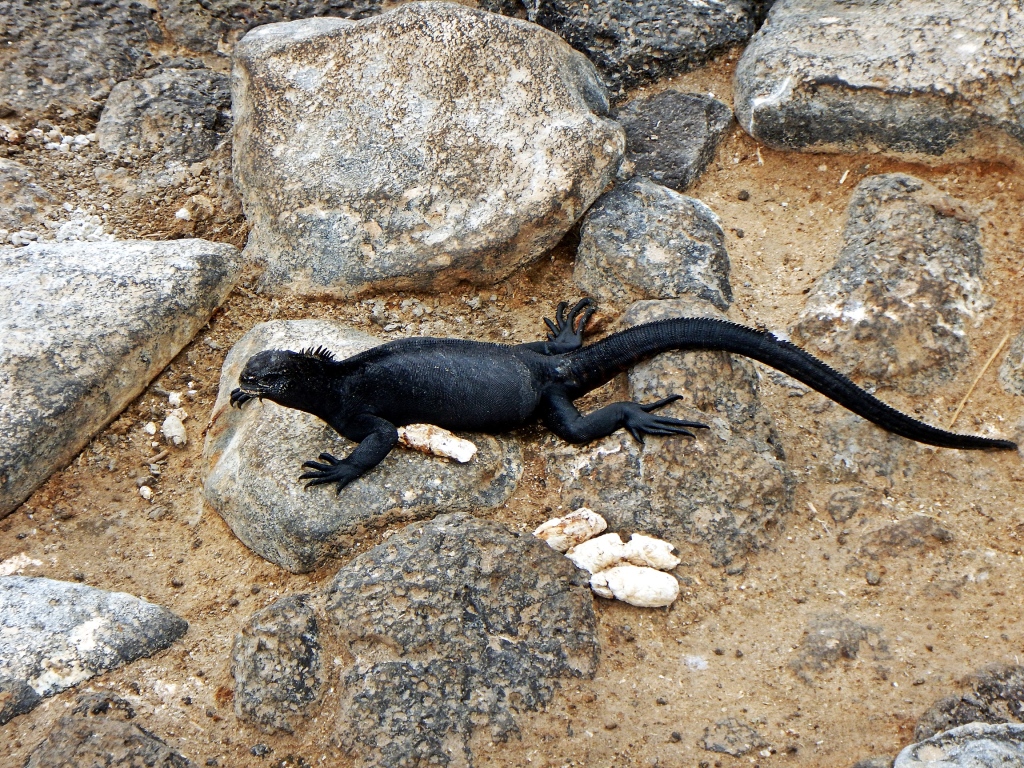
Marine iguana, Galapagos 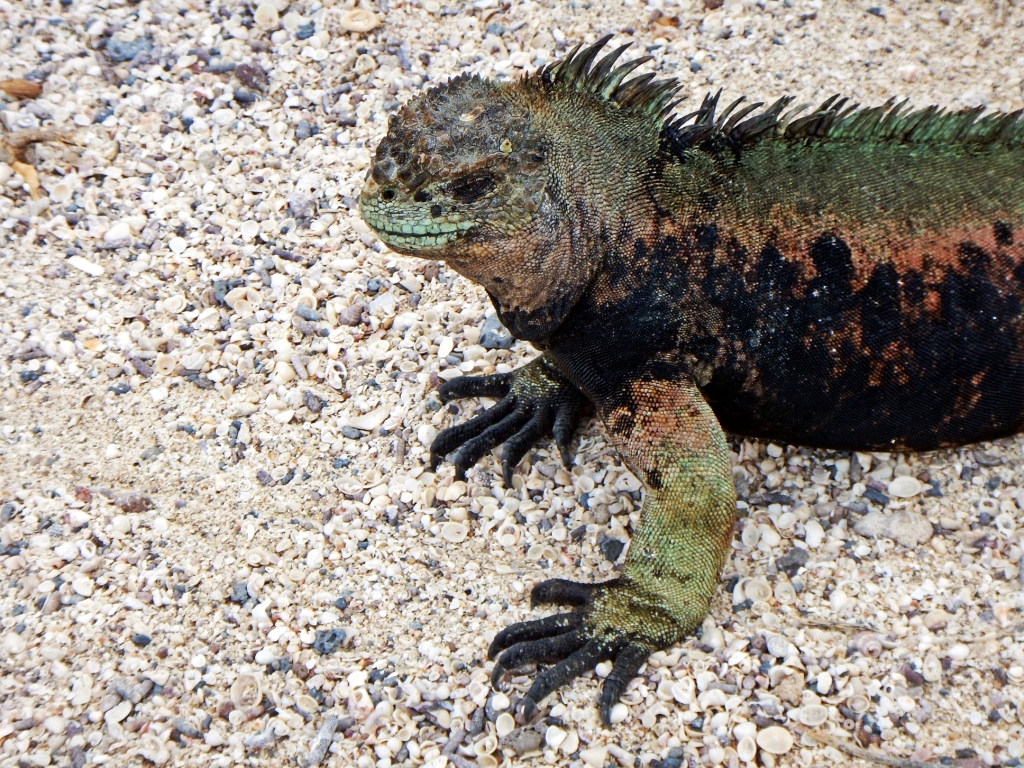
Marine Iguana, Galapagos 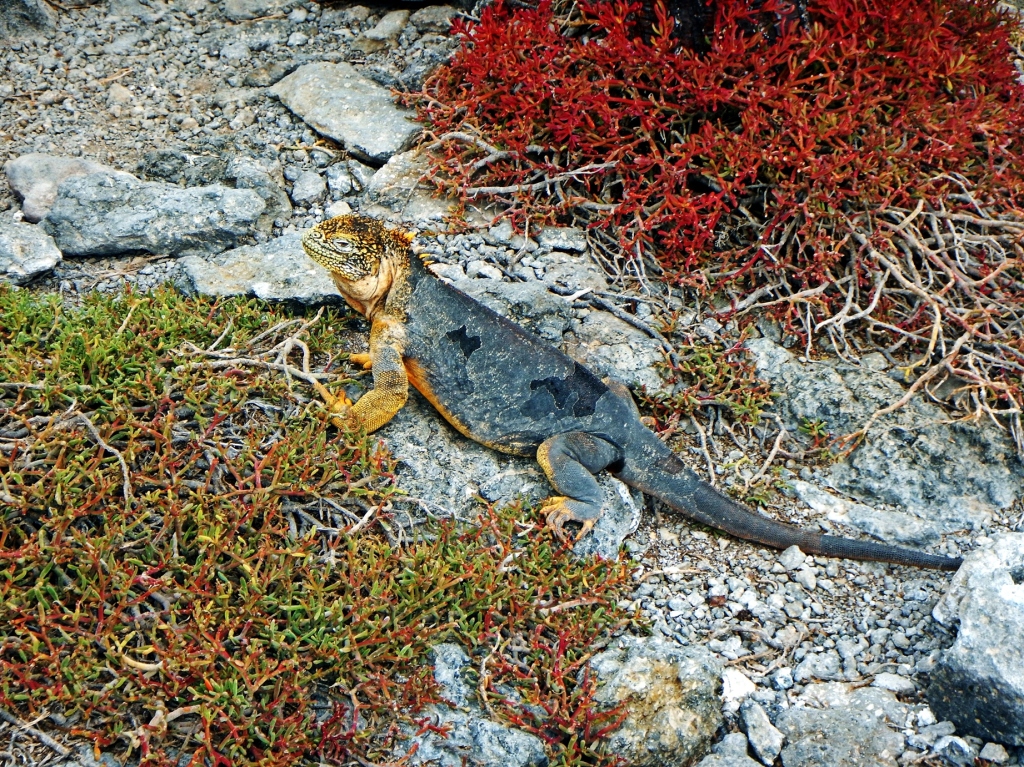
Land iguana, Galapagos 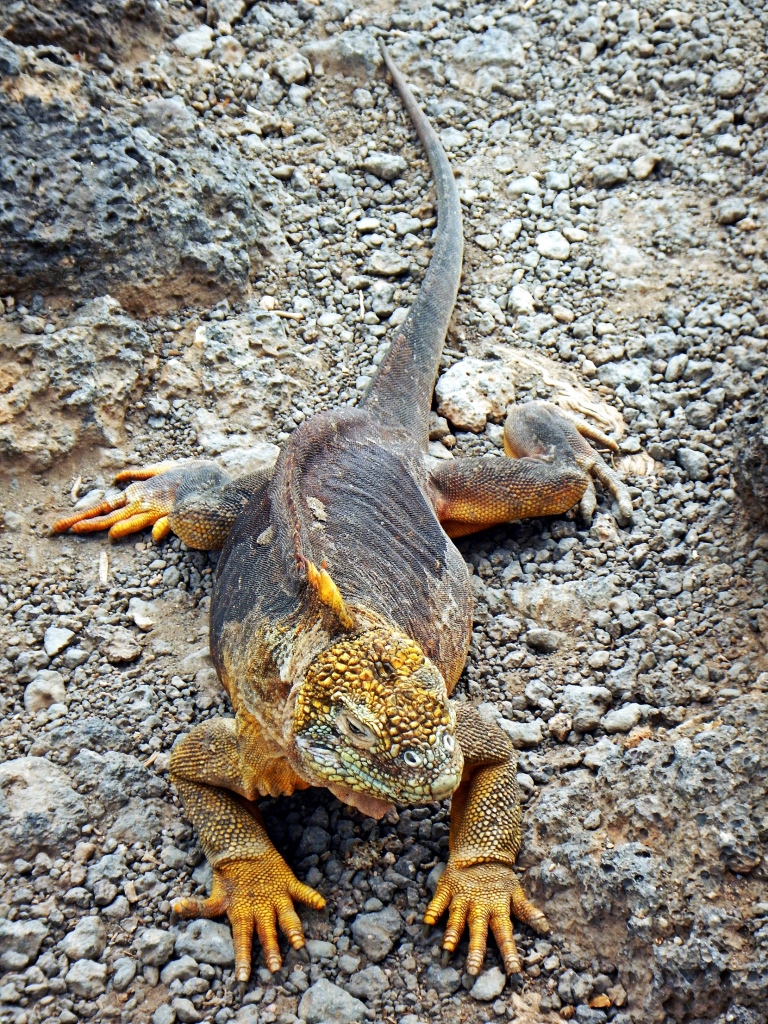
Land Iguana, Galapagos 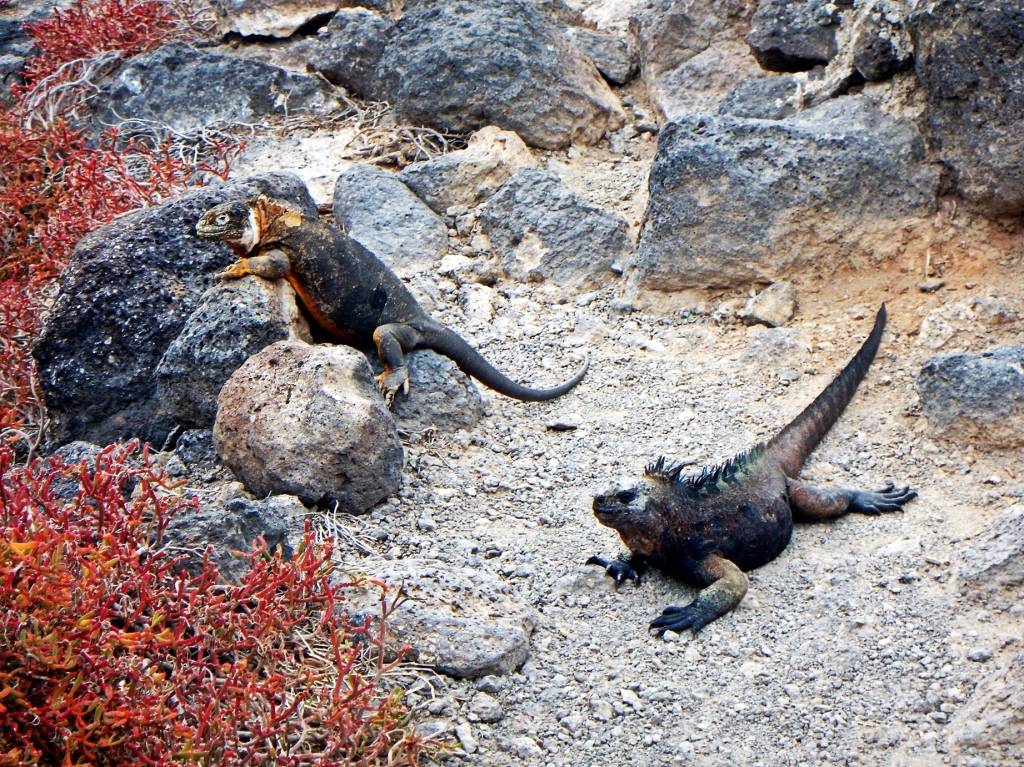
Marine and hybrid iguanas, Galapagos 
Hybrid iguana, Galapagos
Sea lions are abundant on most of the islands and in the water. They are large, clumsy things on land, but are so much fun in the water. They love to play with you when you’re snorkeling by swimming somersaults and spinning around you. They came so close that sometimes our pictures are just of their nostrils. We only swam with one Galapagos penguin. He swam by us like a torpedo when we were snorkeling. I thought they’d be fun to swim with, but he wanted nothing to do with us.

Baby Sea Lion, Galapagos 
Juvenile sea lion, Galapagos 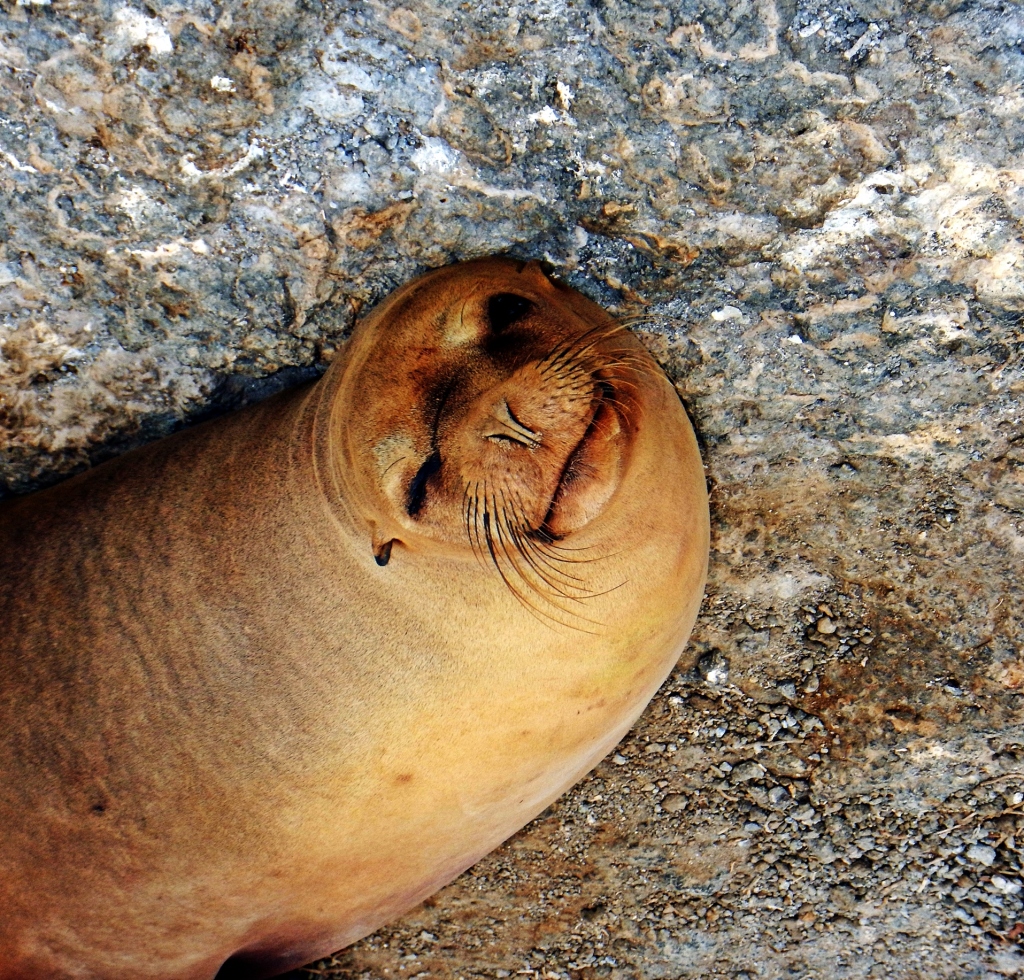
Smiling sea lion, Galapagos 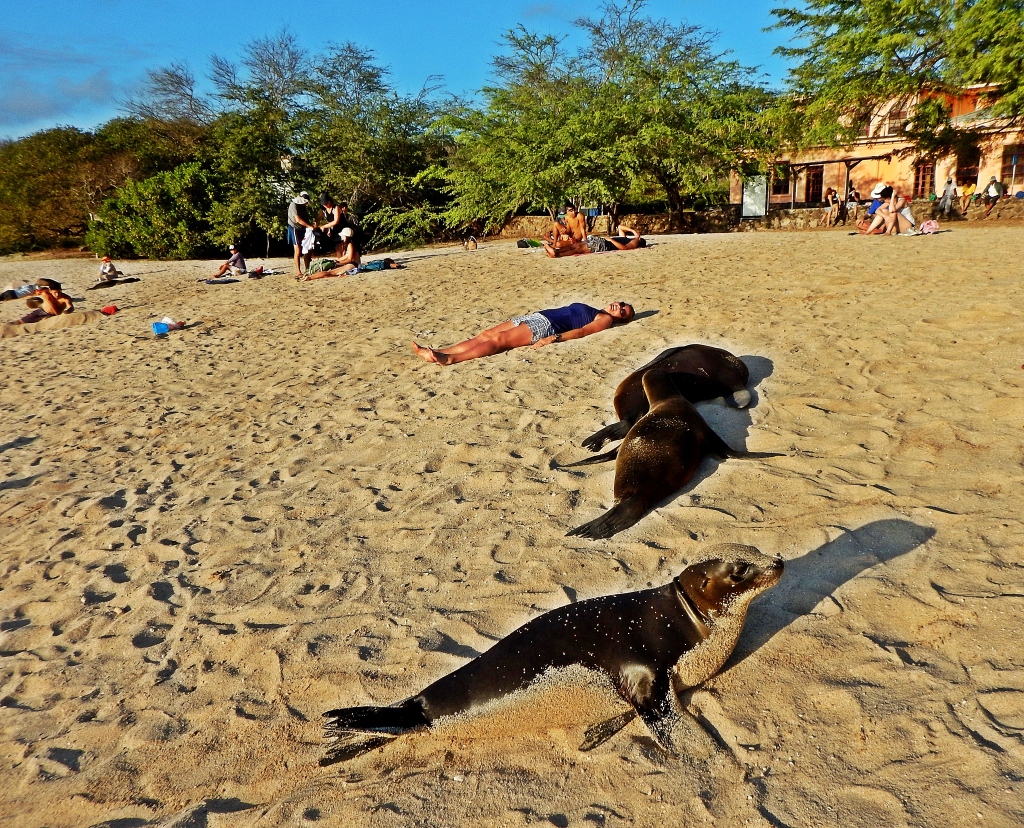
Sea Lions, Puerto Baquerizo Moreno,beach, Galapagos 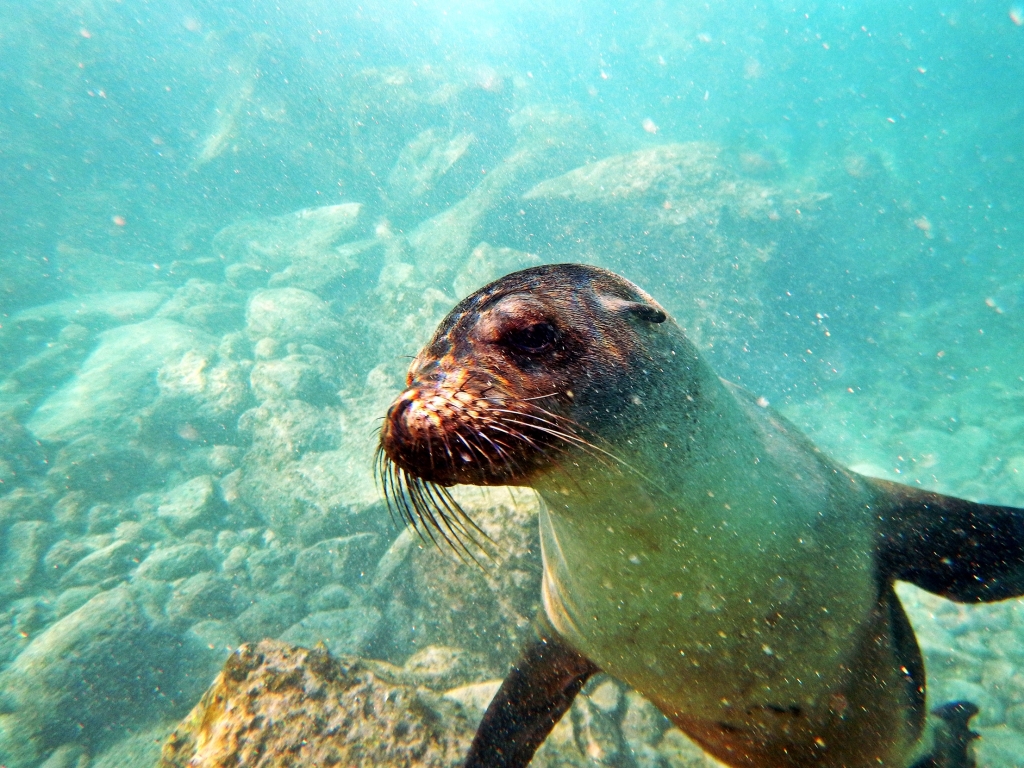
Swimming with a sea lion, Galapagos 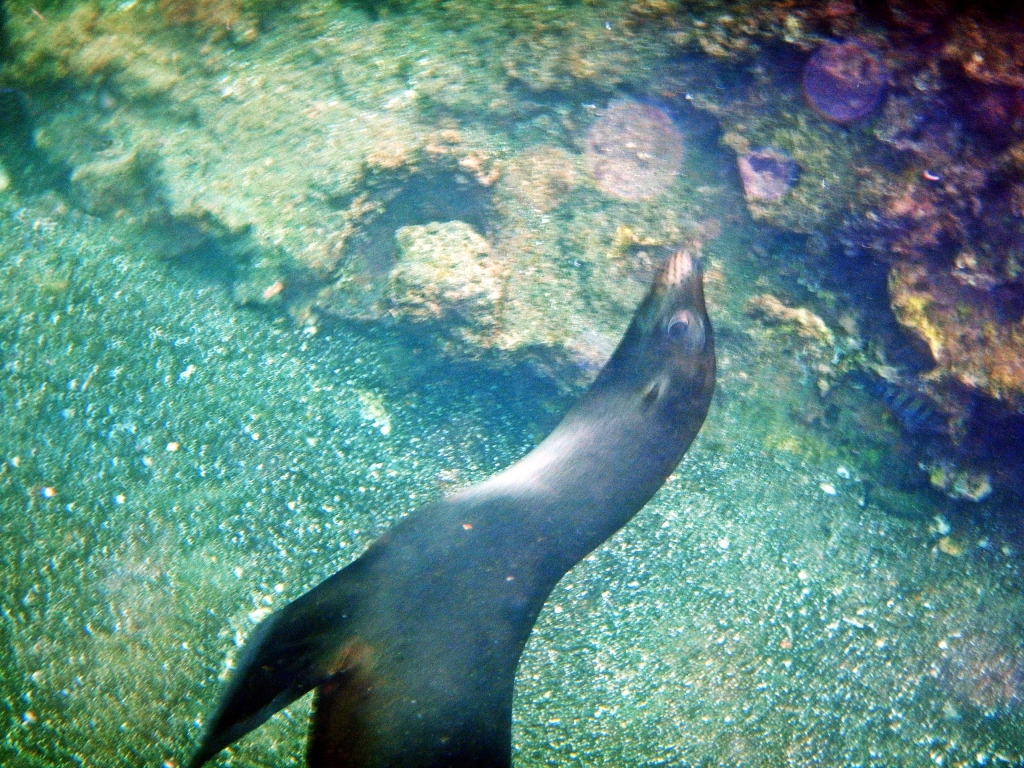
Playful sea lion, Galapagos
Some islands have resident giant Galapagos turtles, which can weigh up to 417 kg. When we were driving on one of the islands there was a giant turtle in the middle of the road, blocking traffic. It took two park rangers to carry it to the side of the road. Other islands have hatching grounds for green turtles. We didn’t see these turtles, but did see their tracks in the sand as they went back to sea after laying their eggs.
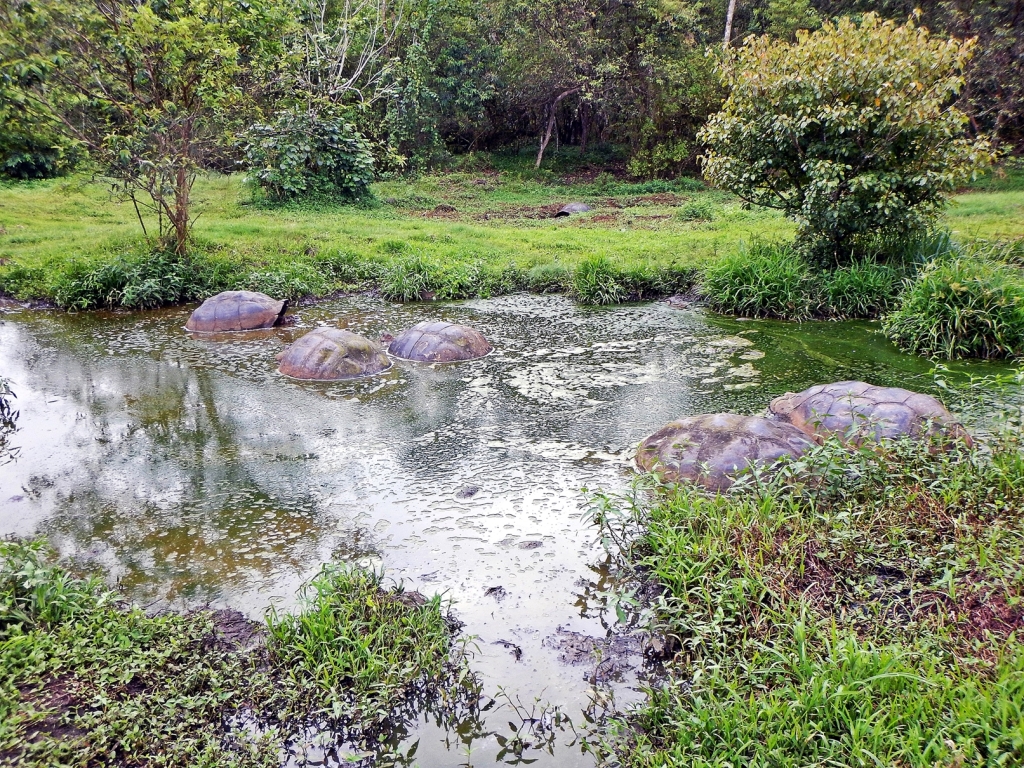
Galápagos giant tortoise in a pond 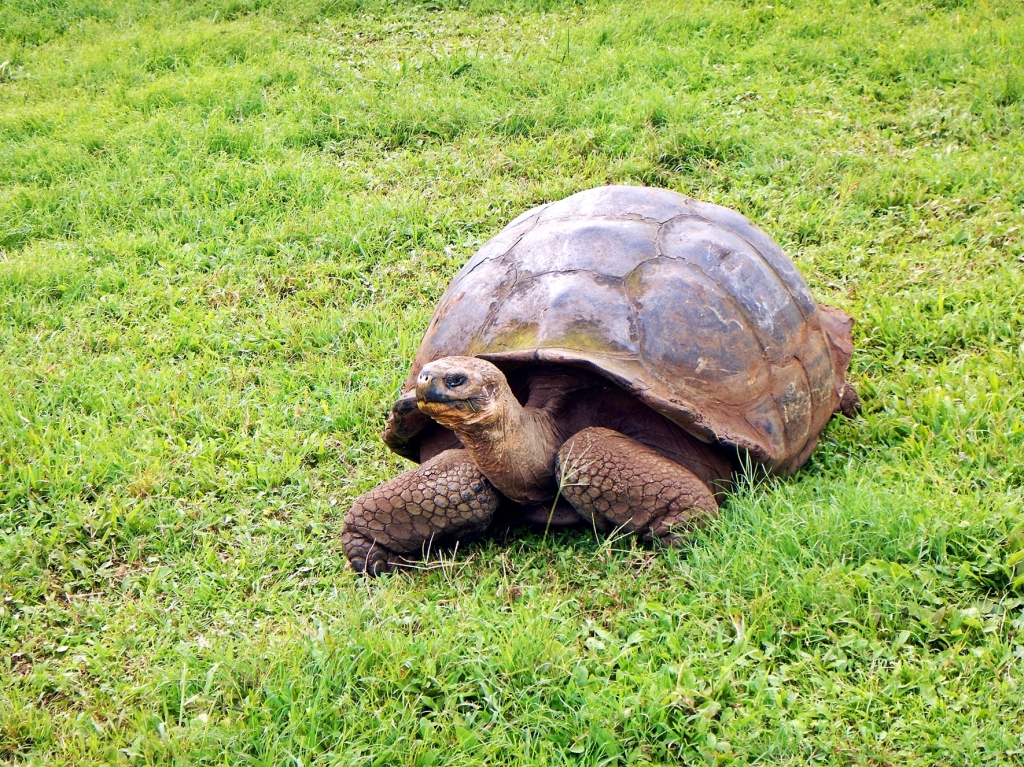
Galapagos giant tortoise 
Galapagos giant tortoise 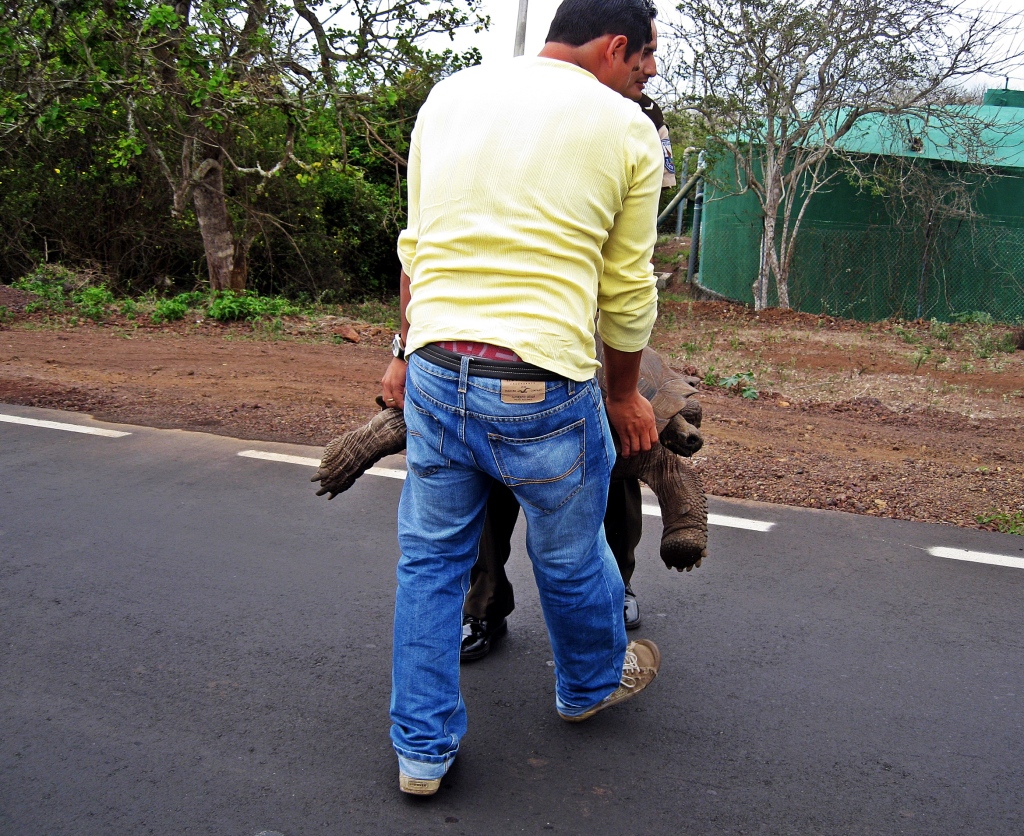
Moving a Galapagos giant tortoise off the road 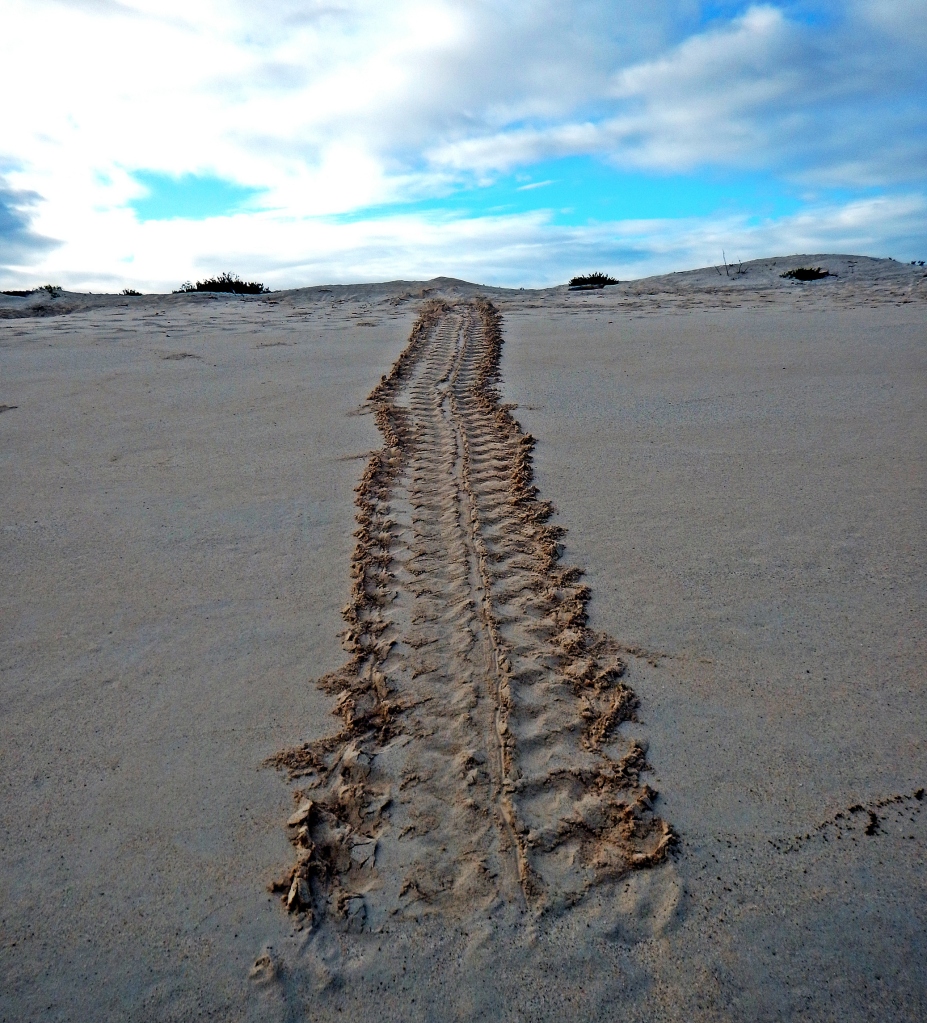
Green Sea Turtle tracks in the sand, Galapagos
There are numerous birds in Galapagos. The famous Darwin finches include 15 different species that have varying characteristics depending on the food available to them on each island. Darwin noticed the differences in these birds and began to develop his theories of evolution. The main differences that you can see are the beaks which range from short and stubby to long and thin; their colouring that ranges from black to yellow; and the different sizes of the birds. They are very flighty birds, and it was difficult to take pictures of them but here are a few pictures to help you understand the differences that started Darwin’s theories. It really made us realize how curious he had to have been to take note of these differences and want to understand why they occur.
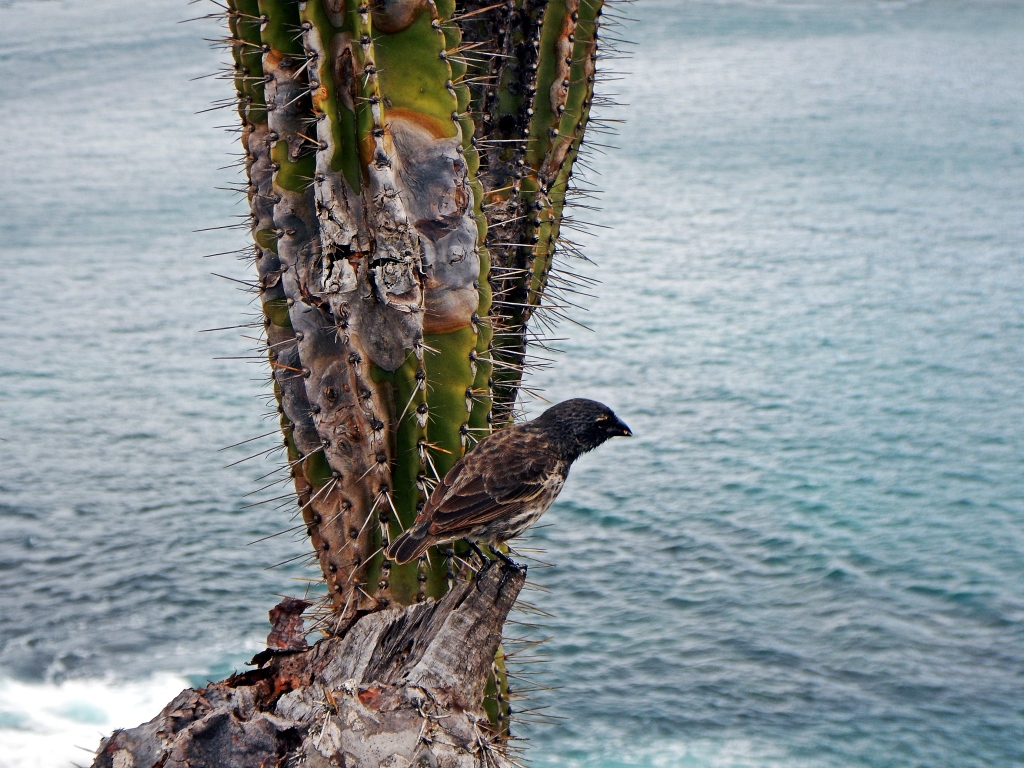
Cactus finch, Galapagos 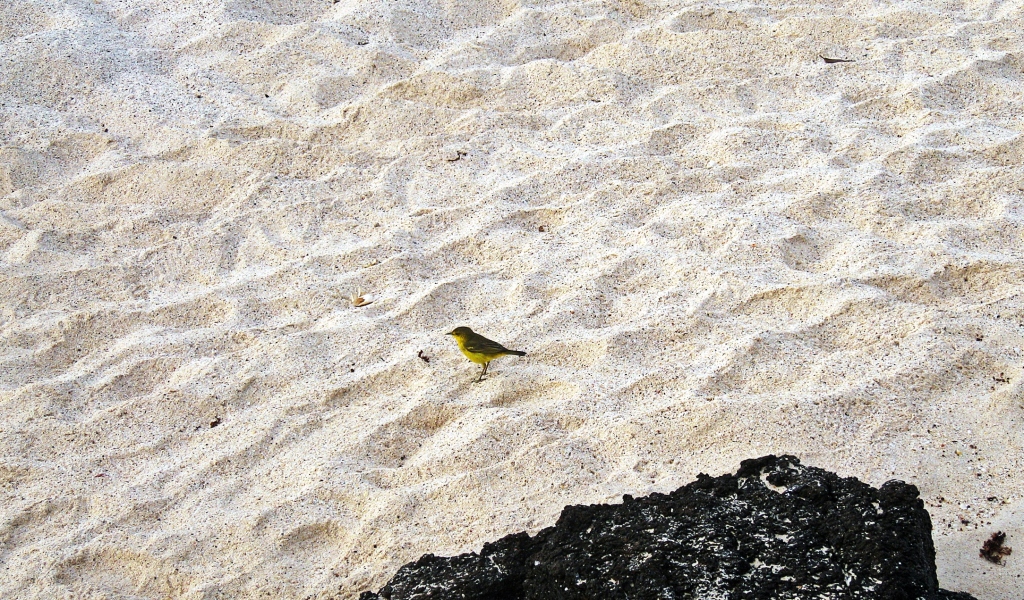
Galapagos finch 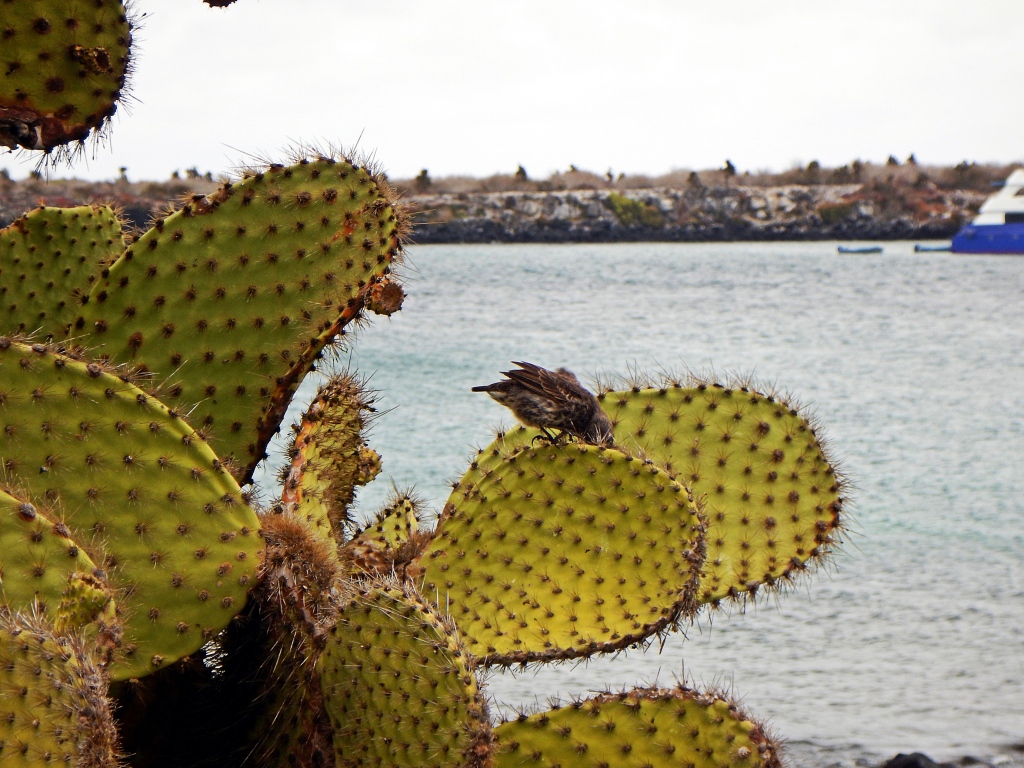
Cactus finch, Galapagos 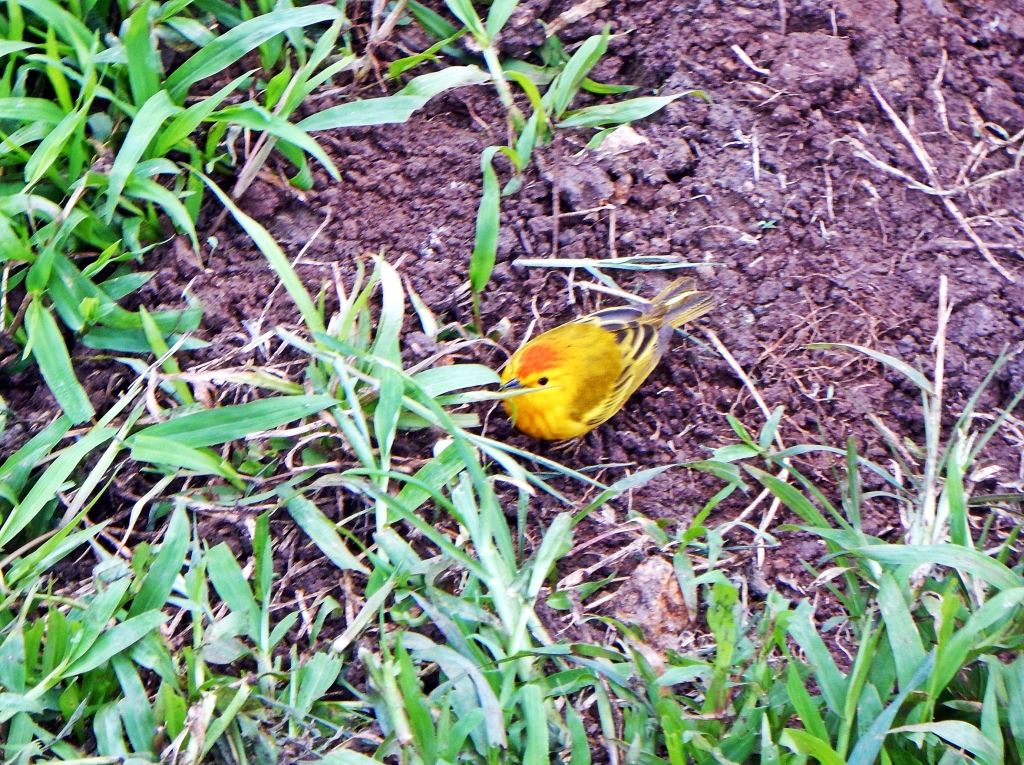
Galapagos finch
More entertaining than scientific, we walked through a field to see frigate birds. The males were displaying their huge red gular sacs on their necks. They use these sacs to attract females. They look so awkward trying to move their heads, but the funniest thing was watching them fly with this huge red balloon hanging down.
Also funny to look at is the blue footed booby. Their feet are bright aquamarine blue contrasting to their white bodies and their piercing eyes. They have excellent vision which helps them be such good fishermen. The problem is they dive with their eyes open and after a few years, there is a lot of damage to their eyes. Older birds often become blind. We did see a few dead boobys lying on rocks. Apparently, this is common as they misjudge the water with their failing eyesight and crash into rocks instead of water.

Male Frigates, Galapagos 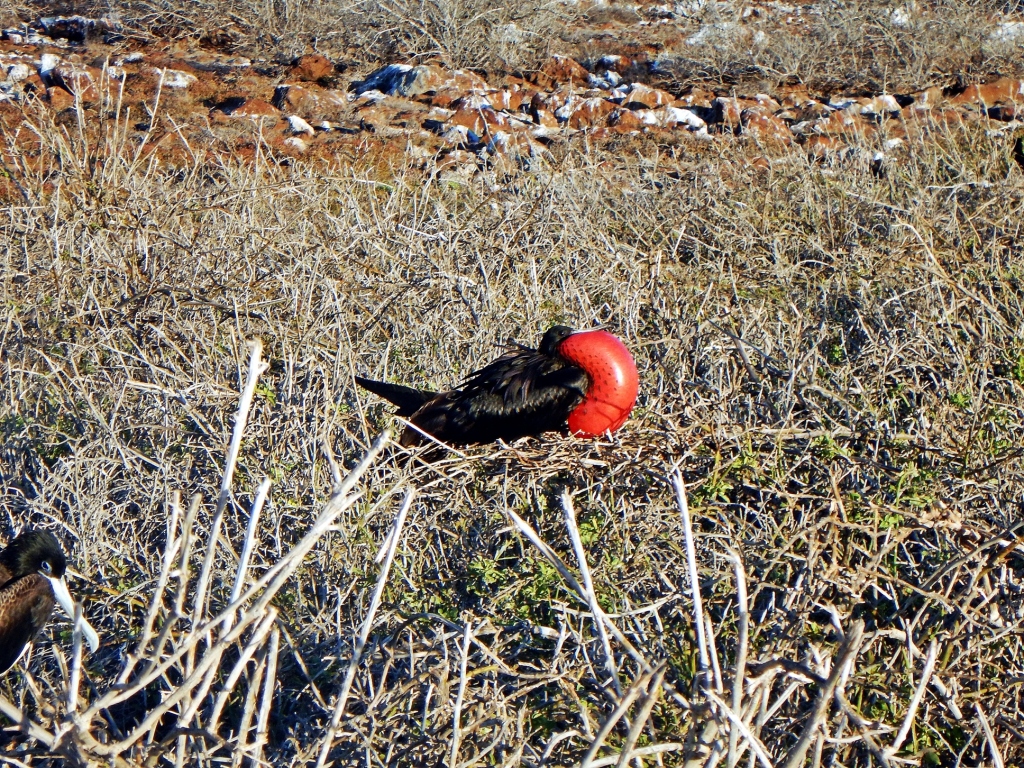
Male frigate, Galapagos 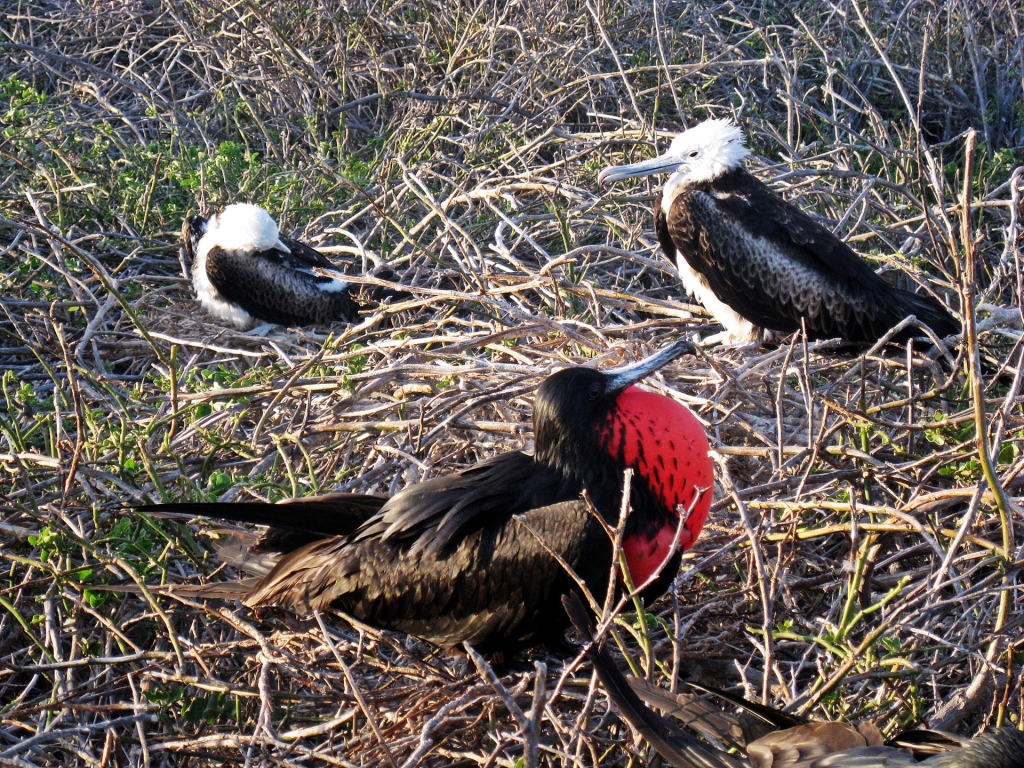
Male and young frigates, Galapagos 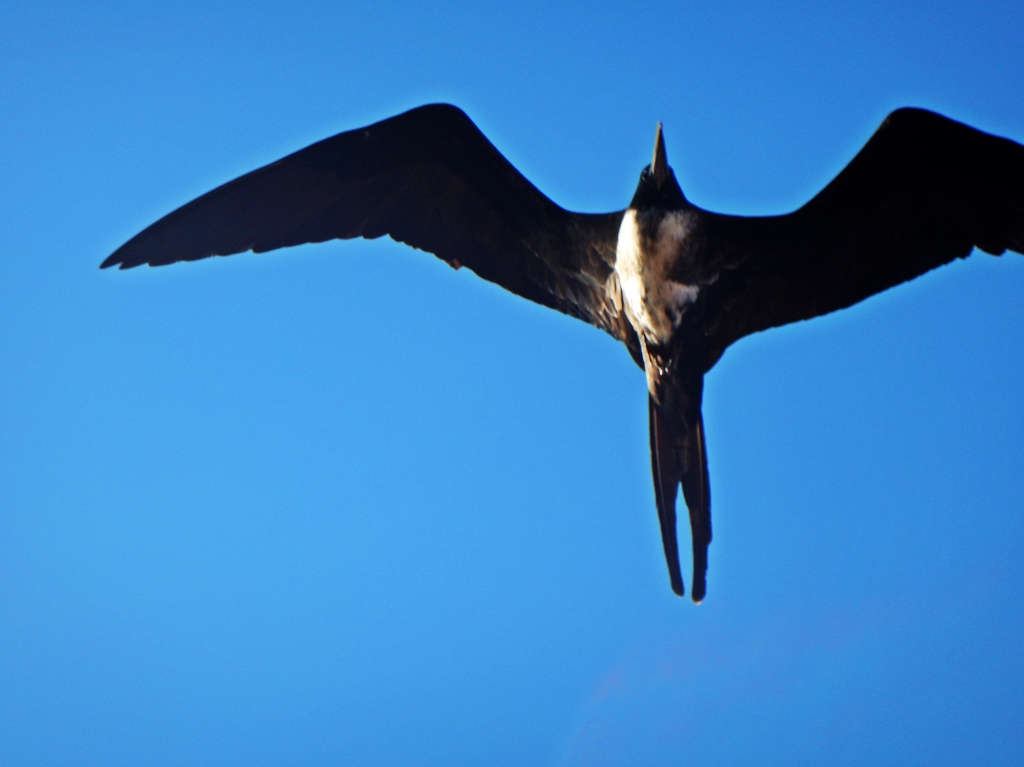
Female Frigate, Galapagos 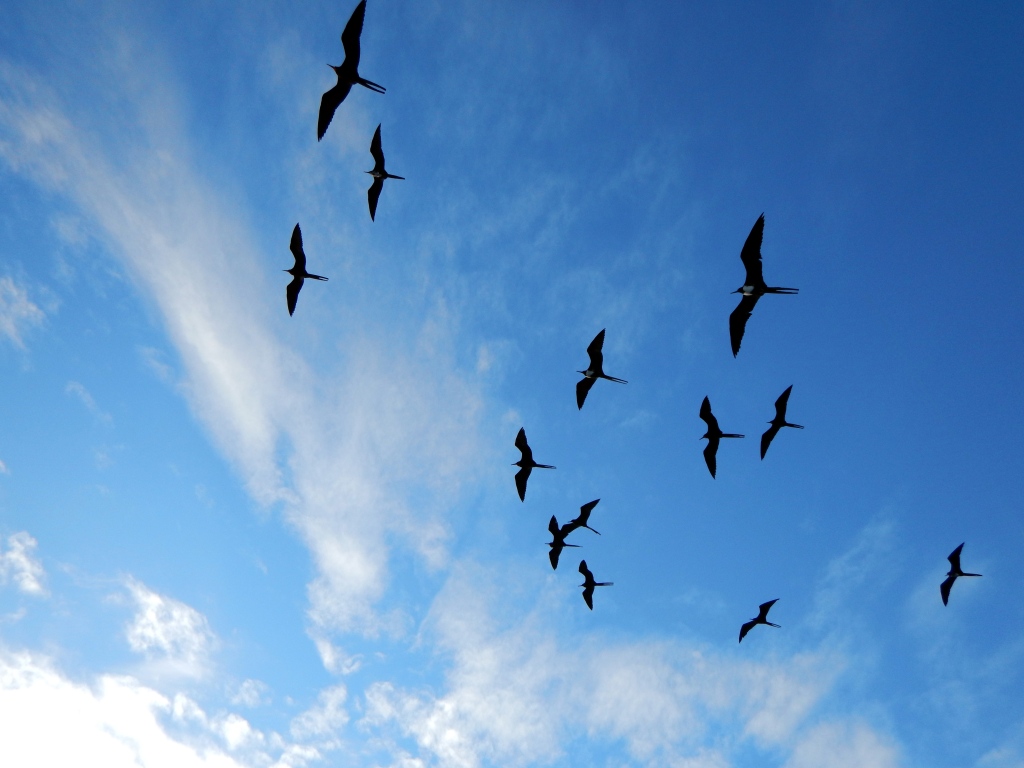
Frigates, Galapagos 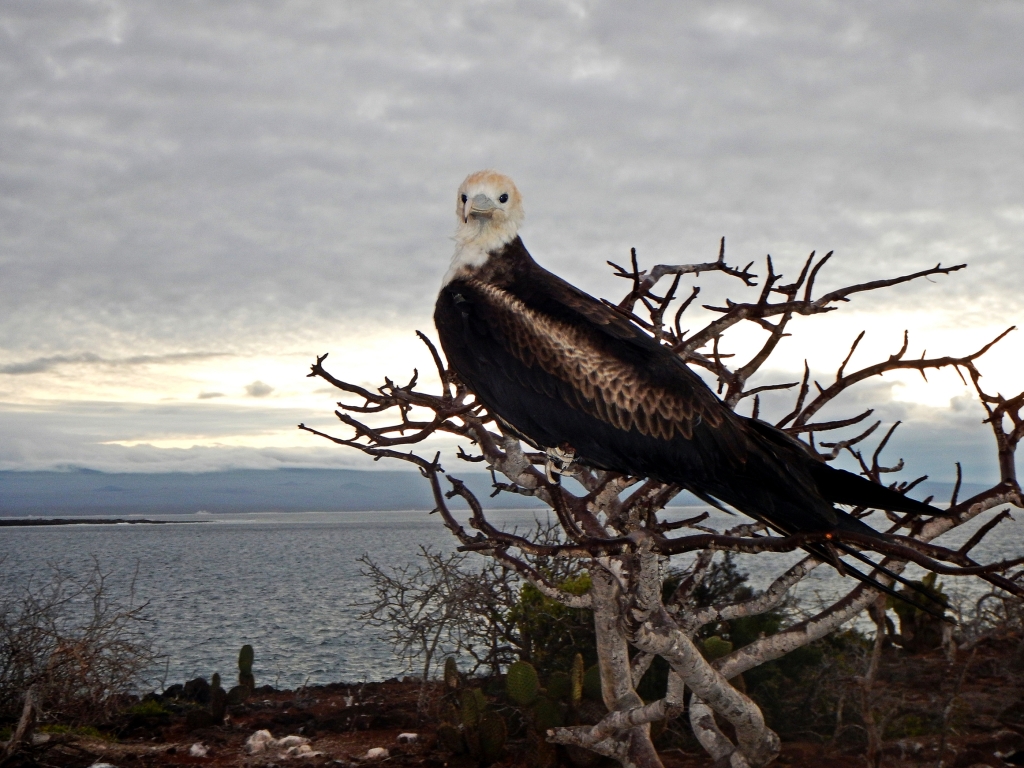
Young frigatebird on a palo santo tree, Galapagos 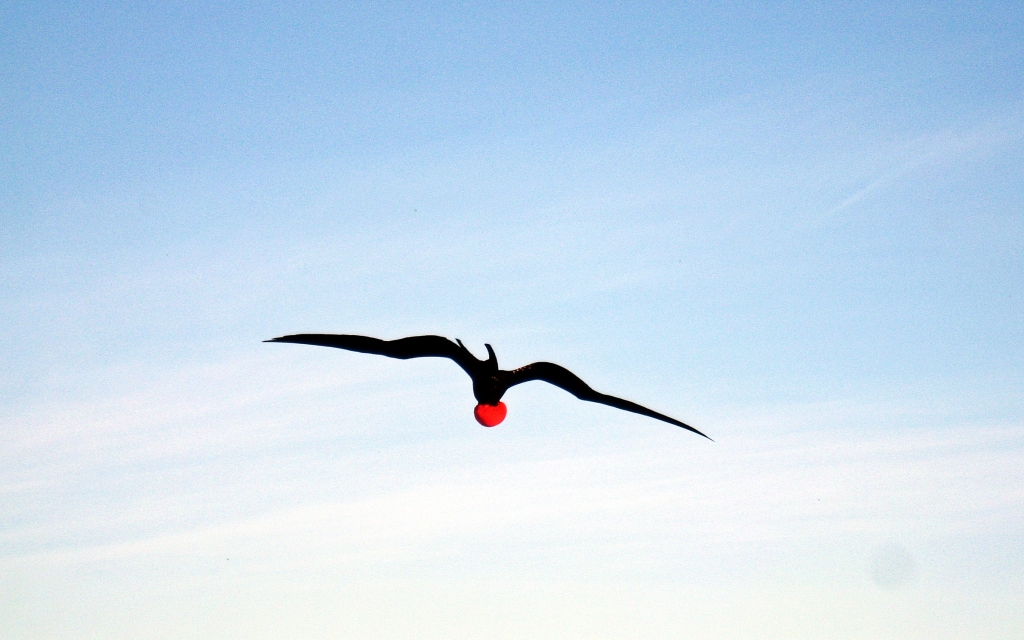
Male frigate flying, Galapagos 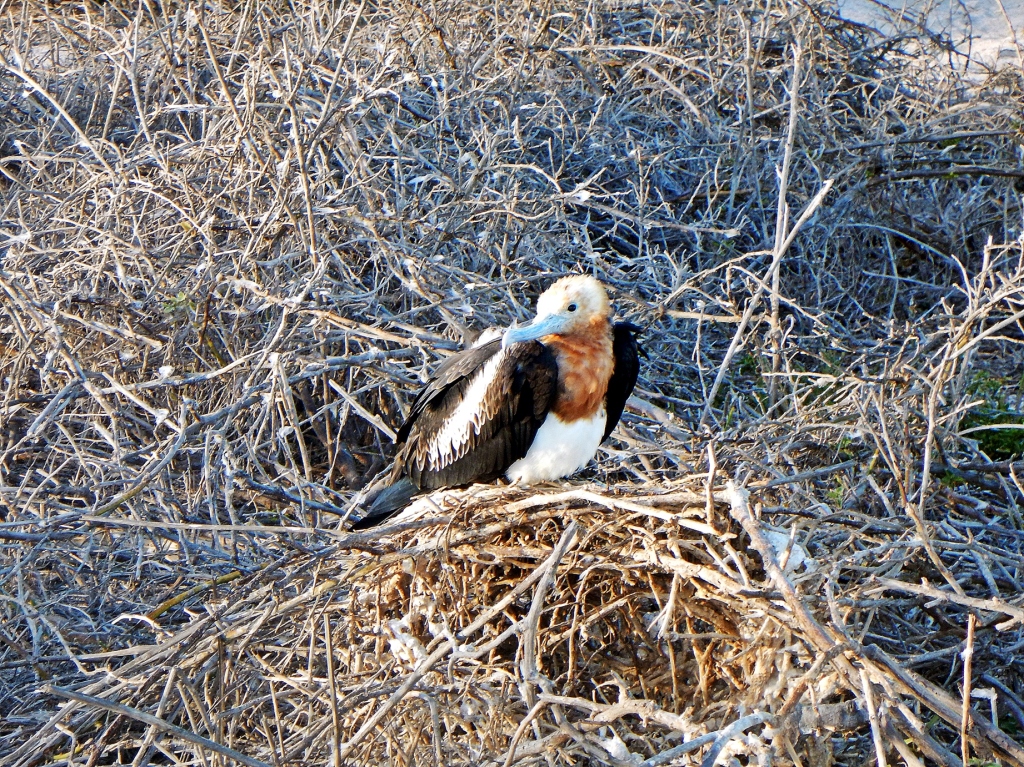
Young Frigate, Galapagos 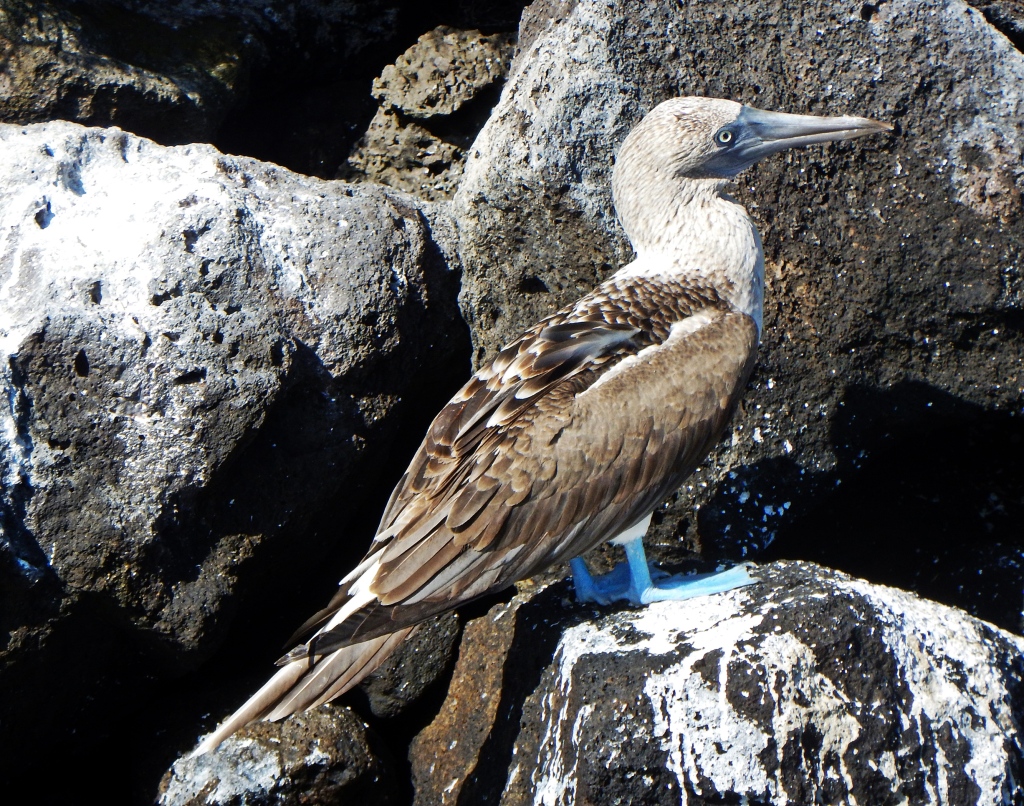
Blue footed booby, Galapagos 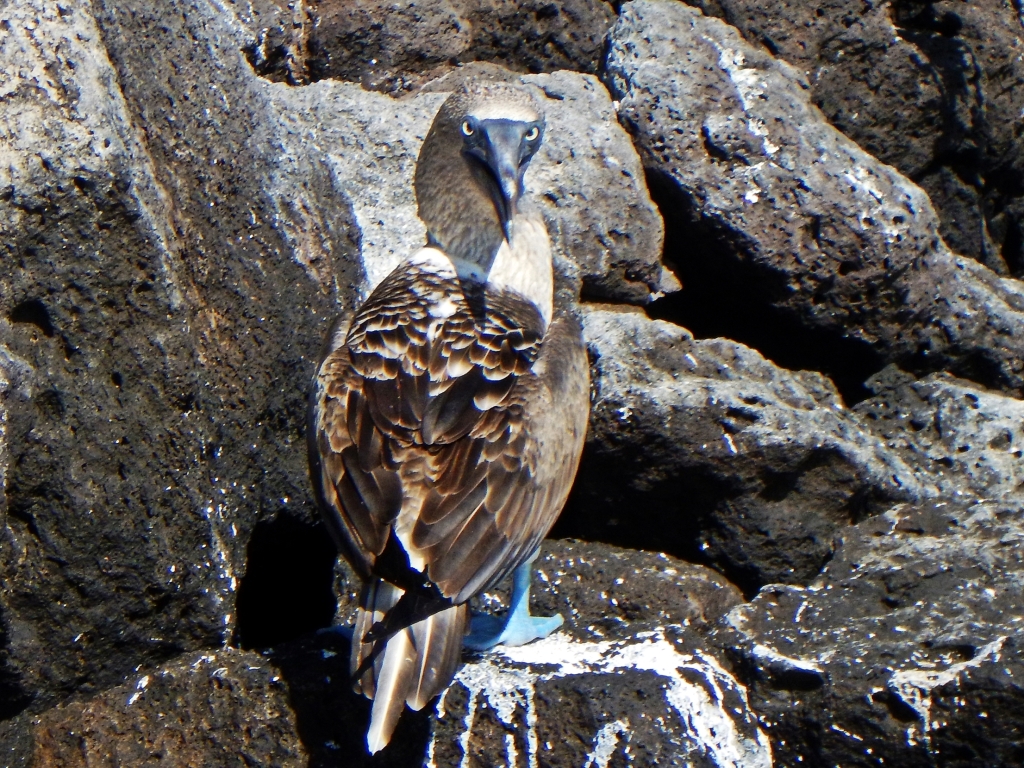
Blue footed booby, Galapagos 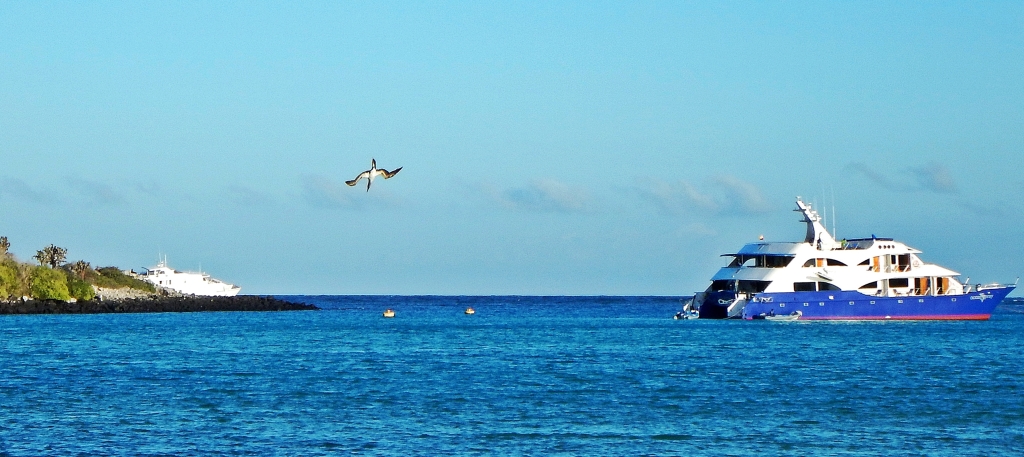
Blue footed Boobie diving, Galapagos 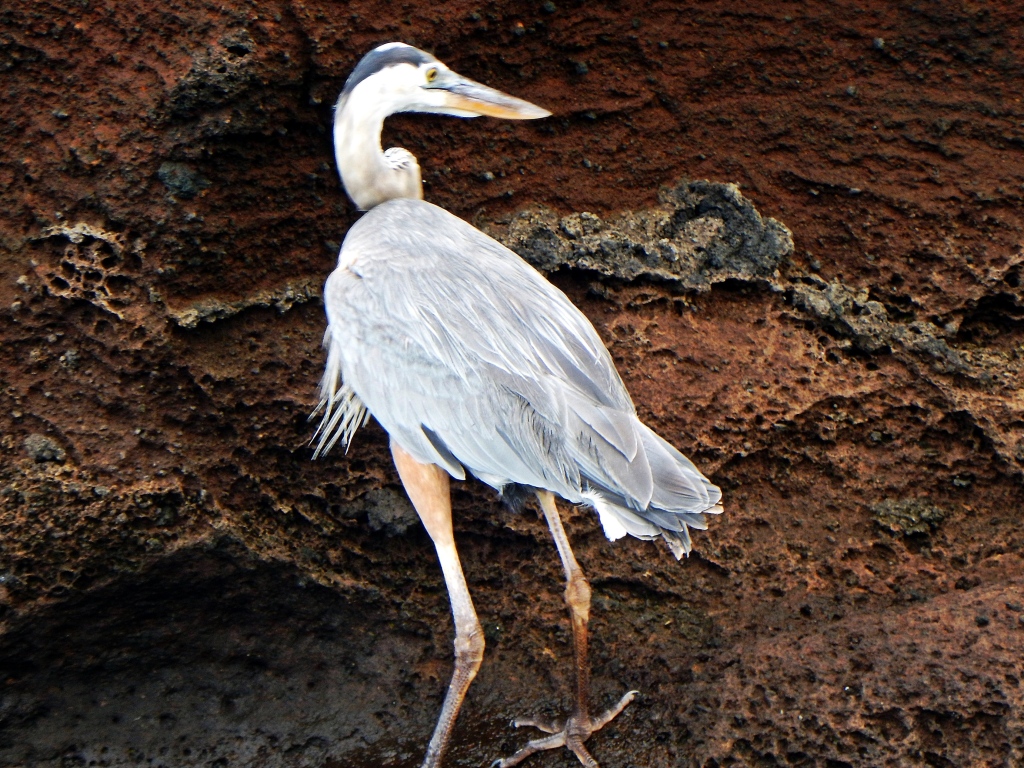
Blue Heron, Galapagos
There is amazing diving in Galapaogs. At Kicker Rock we saw huge schools of jack fish. One school formed such a large wall that they blocked out the sun. There were large flocks of eagle rays, and many colourful reef fish. We dove at Shark Point near Wolfe Island. Not only did we see a lot of sharks but we stopped at one spot to watch as hundreds of sharks swam past in a tight formation making it look like a busy highway of sharks. If you’re not an experienced diver be aware that many of the dive sites have very strong currents. Even as experienced diver, Richard was swimming about 1 m above Maggie when he was suddenly pulled up out of the water by a strong surge. He was tossed on to rocks and then sucked back in to the water. The description from the people on the boat was hysterical. They saw a diver doing a cartwheel across the surface rocks before landing back in the water. Thankfully he was okay, but there was confusion as to what happened to him for a while.
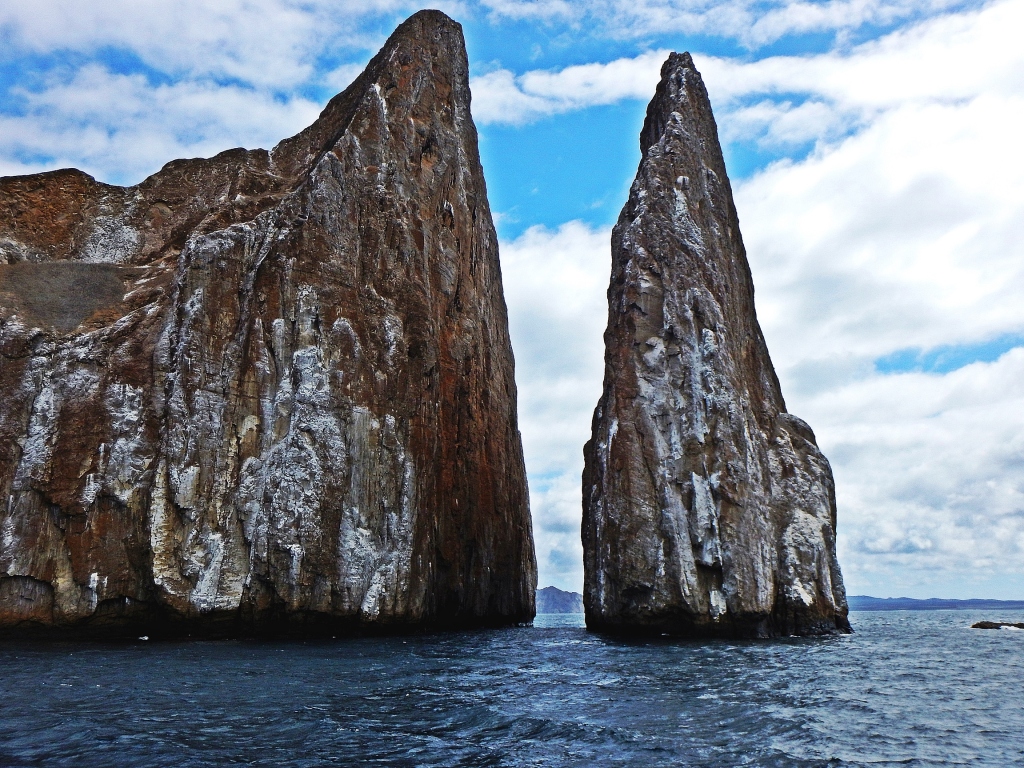
Kicker Rock, Galapagos 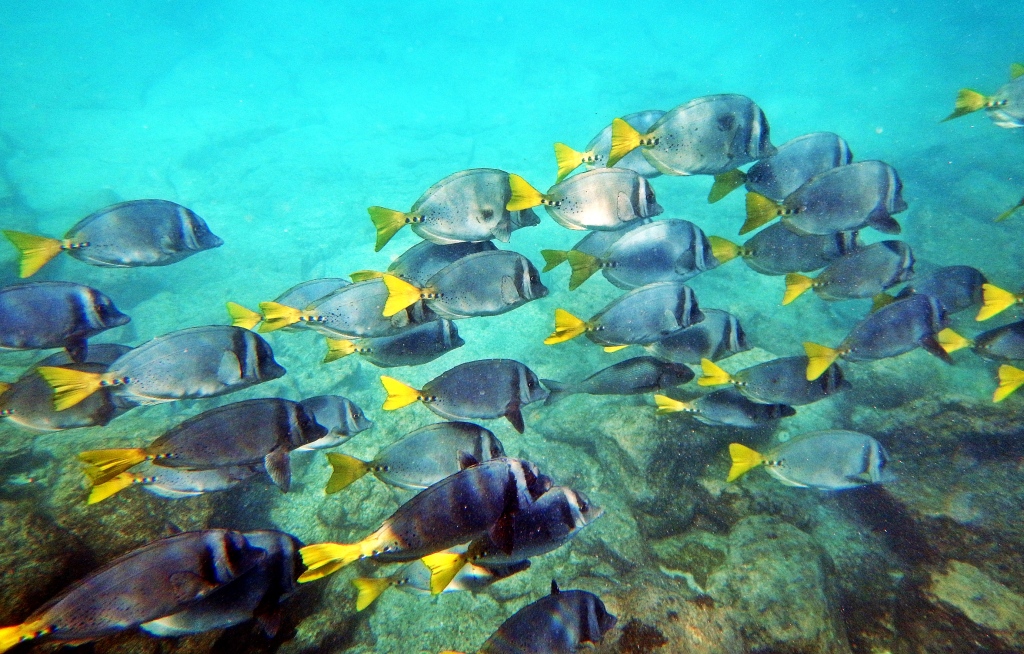
School of reef fish, Galapagos 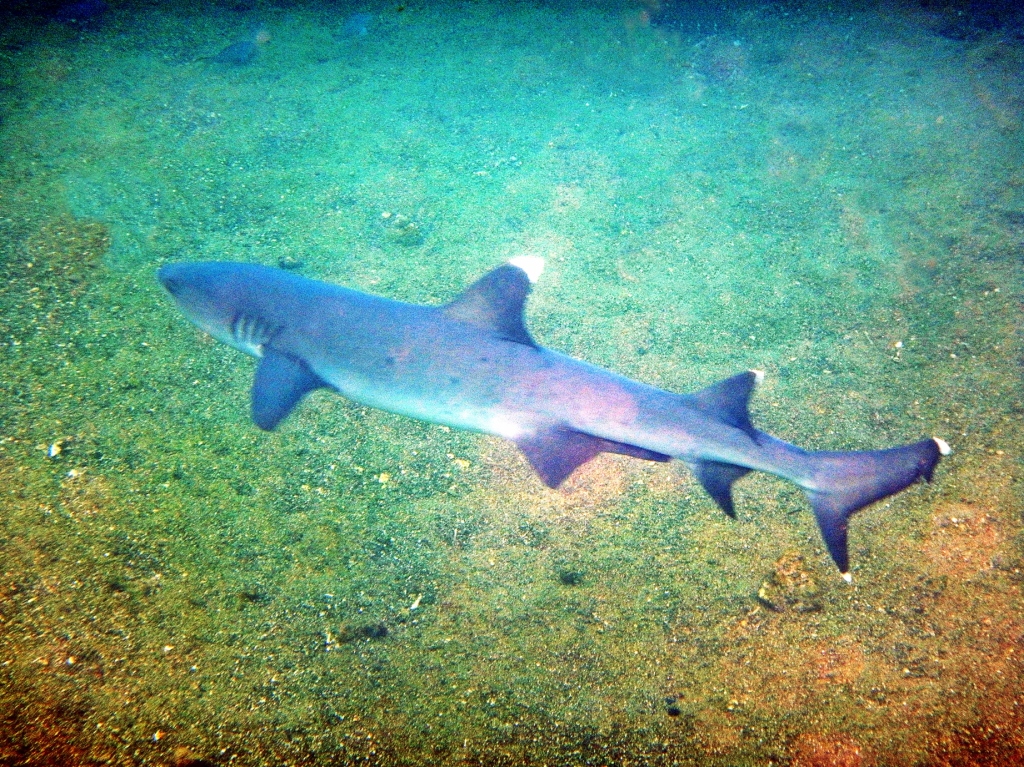
White tip shark, Galapagos 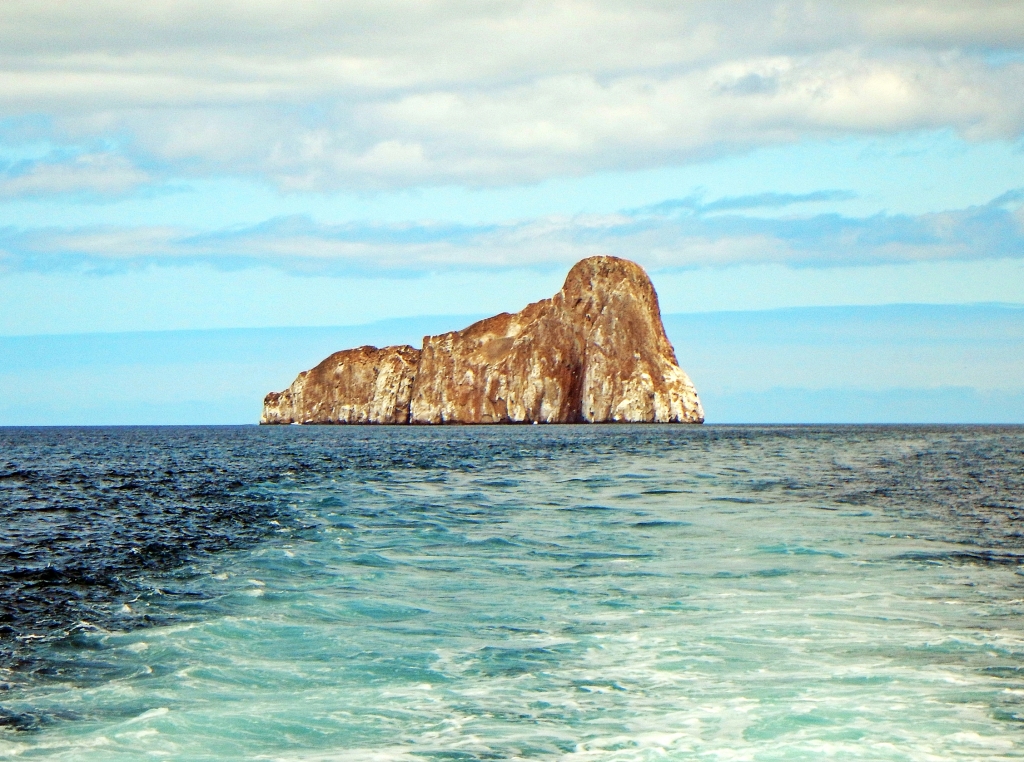
Kicker Rock, Galapagos 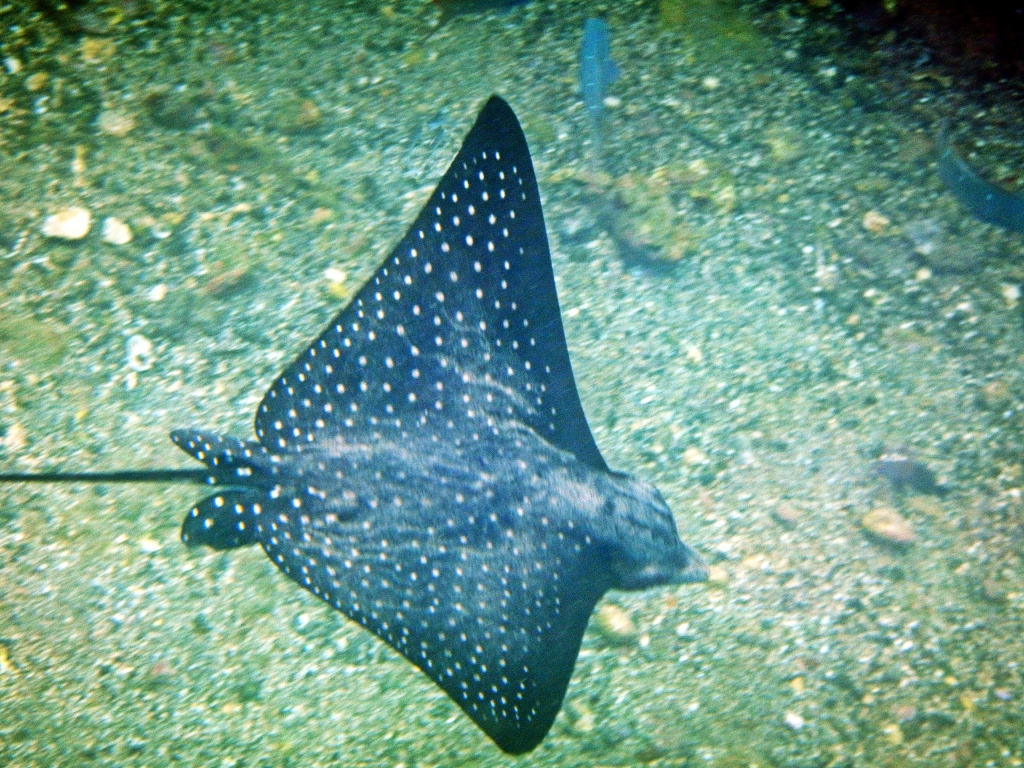
Eagle ray, Galapagos
Choosing your type of visit to the Galapagos:
Staying on an island – Hotels are only allowed on the inhabited islands of San Cristobal, Santa Cruz, Floreana and Isabela. There are many day trips from each island, but you’re limited to how far you can go.
Cruises – You have to choose between a dive boat or a cruise boat. No boat does both:
- Dive boats – If you dive, you can visit many of the incredible dive sites in the area, but you can not visit any of the uninhabited islands.
- Cruise boats – If you go on a cruise boat, you will see many different islands with a large variety of plants and animals. On these boats though, there are opportunities to snorkel, but not dive.
Choosing a cruise boat
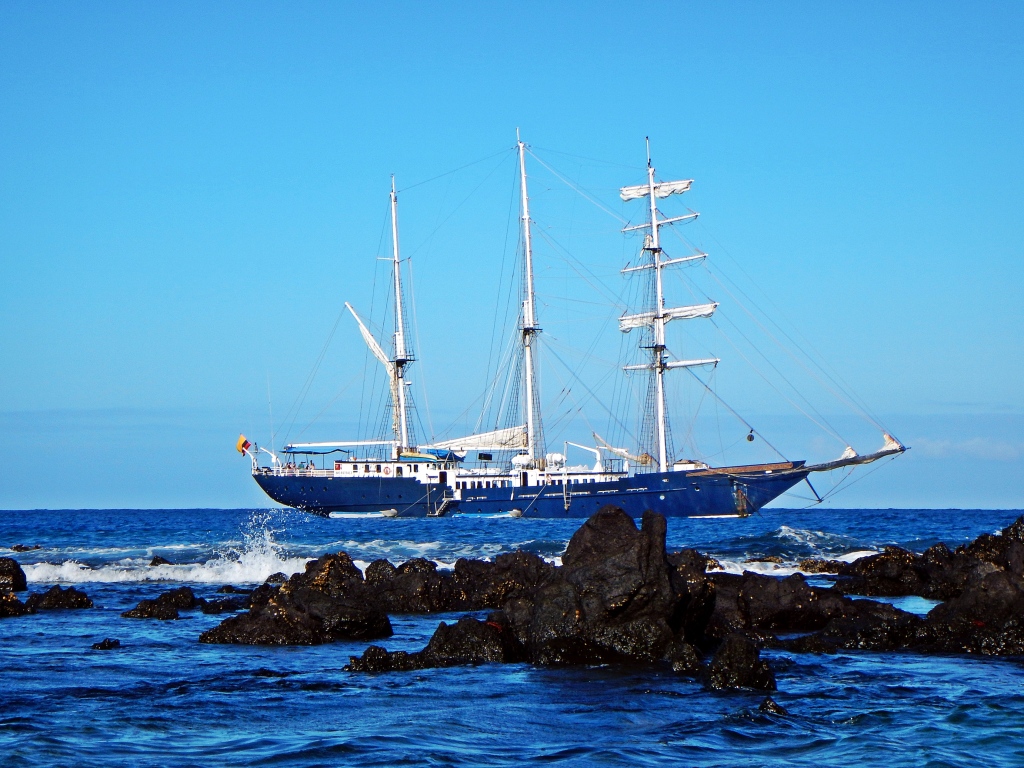
Sailboat, Galapagos 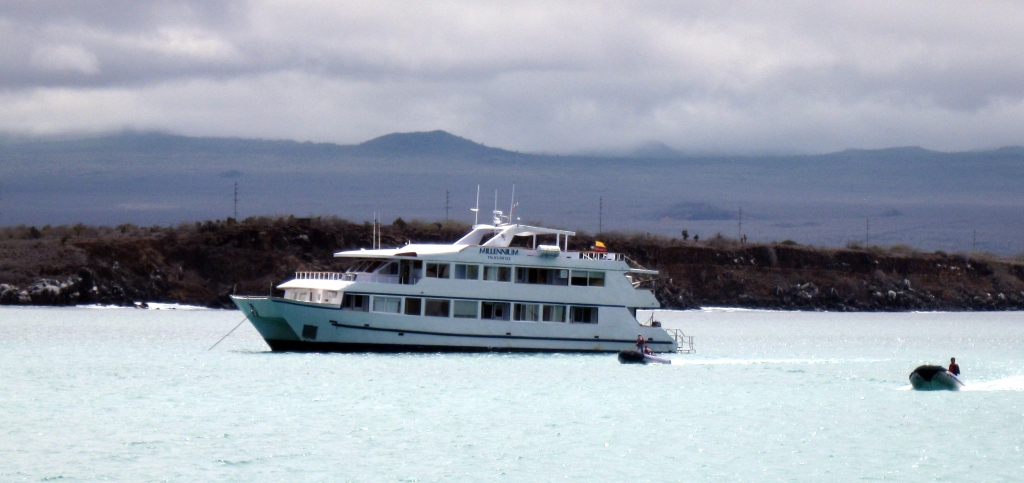
Cruise boat, Galapagos
- Decide on the length of time – We did a 5 day 4 night cruise which really means 2 half days and 3 full days as the first and the last are only half days. and for us that was the best amount of time. This amount of time allowed us to visit a few different islands, see a variety of animals and plants, but it wasn’t so long that we were bored.
- Decide what you want to see – There are many different itineraries that include different islands, so do research on the islands first and decide which ones are on the top of your list. The look at which itineraries fit your interests.
- What size of boat is best – Smaller boats will be less stable, but as there are fewer people wanting to go to shore you will be able to visit all of the sites. Large boats are more stable and therefore easier on the stomach. The problem is that because there are so many people, not everyone gets to go on every excursion.
- All cruises will include A naturalist guide certified by the Galapagos National Park Department. You must have a guide to access the uninhabited islands of the national park.
For more pictures from Ecuador and video from our dive watch the YouTube presentation:
Whatever you chose, you’ll love your time in the Galapagos.
Coming Up Next: The Most Beautiful Colonial Towns in Colombia
For extra pictures from other blogs go to Gallery at monkeystale.ca
To read about more of our adventures go to Destinations.
If you like what you read, please comment or share (with credit) using the links below
Great post! Love the sea lions!
LikeLiked by 2 people
Thank you! The sea lions ended up being our favourite animal!
LikeLiked by 1 person
Fascinating place and photos. Thanks for sharing. Allan
LikeLiked by 2 people
Thank you Allan, it’s an incredible place!
LikeLike
Superb! Big fan of the Iguanas, they look impressive. We got one on our hut right now making noise like a squeaky toy🙂
LikeLiked by 2 people
The iguanas were great and so many of them. These ones were very passive but I’m not sure I’d want one under my hut!? Where are you Philioines still?
LikeLiked by 1 person
They look fantastic. Yup still in Philippines. It’s strange, we got one that seems to like hanging out on the roof. Quite noisy too, gave us a good fright the first time!
LikeLiked by 1 person
It would definitely scare me! We are in Colombia now and saw a few iguanas sunning themselves on tree branches over the river when we were whitewater rafing!
LikeLiked by 1 person
An absolutely fantastic place I am sure I would love to die … I love animals and nature … my favorite habitat❤
LikeLiked by 1 person
Then you should definitely go!! You would love it!
LikeLike
The baby sea lion melted my heart! I also never really noticed or focused on the fact that these islands are home to cacti like the prickly pear, which I am so familiar with here in Texas!
LikeLiked by 1 person
I still want to take home that baby sea lion everytime I see that picture😊 There are a lot of prickly pear cacti but I think the species there is different and unique to Galapagos. They sure made interesting landscapes.
LikeLiked by 1 person
So much fun following your adventures. I was down in the Galapagos islands in 2003 and it still looks as amazing now as when I was there. I hope to get my family over to see everything one day as well. My wife and I did get to climb some of those volcanoes on the main land though. I think we had the same view of from the top of Cotopaxi as you. We never did make it to the summit of Chimborazo though, reason to go back I guess. What time of the year where you there?
LikeLiked by 1 person
This is Tyson from Restless crusade. Keep posting!
LikeLiked by 1 person
Oh I actually thought there were 2 Tysons! Oops!
LikeLike
Thanks Tyson! We loved Ecuador and the Galapaogs too. We actually went before our Asia trip, so 3 years ago in December. We’re traveling in Colombia now and so far really like it. Did you get to Colombia?
LikeLike
SO AMAZING!!!!!!!!!!!!!!!!!!!!!!!!!!!!! What an amazing adventure!!!!!! The Galapagos are truly a paradise!! There are SO many places on this wonderful earth of ours to explore!! I’m so grateful for your blog, and sharing places you have traveled that continues to broaden my worldview!!! 🙂
LikeLiked by 1 person
Thank you Stephanie! The Galapagos aren’t that far from Canada, it’s a place you should visit. I still have to do my response to your award 😊
LikeLiked by 1 person
Hey!!!! I just Googled the Galapagos and they are close to Canada! I imagined they were located somewhere in the Indian Ocean, near Australia! You just planted a seed!!! A new destination on our travel list!!!! 🙂 🙂 🙂 I look forward to reading your response to the Sunshine Award!!! I can’t wait to read what questions you ask! 🙂 Have a WONDERFUL day!!! 🙂 🙂 🙂
LikeLiked by 1 person
The most expensive thing is getting to Ecuador but the cruises in Galapogos are pretty reasonable. Let me know if you have questions as you plan!!
LikeLiked by 1 person
Oh!!! WONDERFUL!!! Thank you Maggie and Richard! I spoke with my husband last night (he’s in British Columbia right now) about your support, when we now plan a trip to the Galapagos!! 🙂 🙂 🙂
LikeLiked by 1 person
Great post and fantastic photos! Few destinations stimulate as much wonder and have inspired as many scientific pursuits as the Galapagos Islands. Given their remoteness and one of a kind natural offerings – it’s such a bucket list experience, your adventures are truly amazing, Maggie and Richard! Thanks for sharing and have a good day. Aiva
LikeLiked by 1 person
Thank you Aiva. It is such an amazing unique place. We would go again which we can’t say about a lot of destinations. Thanks for writing your comments.
LikeLike
I definitely loved my time exploring the Galapagos Islands a few years ago and I look forward to going back again 😀 For a rare non-beach lover like me, that’s a lot to say the least 🙂
LikeLiked by 1 person
Yes Galapagos is one place that we could visit again. Even though we saw a lot we still missed a lot. Thanks for reading!
LikeLike
Wow! Another great post and travels. That lava landscape is very alien like, very beautiful.
Love that cactus tree, reminds me of U2’s Joshua Tree.
LikeLiked by 1 person
They are strange looking cacti as were many things in Galapogos. The lava fields felt like we were on the moon. Thanks for the comments😊
LikeLiked by 1 person
How gorgeous! I visited the Galapagos in 1996 and absolutely fell in love. Your photos take me right back – I even stood in the same place on Bartolome for the classic photo. My personal favourite photo was one that I took of a penguin standing next to a prickly pear cactus – a rather incongruous combination!
I did a 5 day trip on an Economy boat and loved that the small boat could get to places that the larger boats couldn’t. I swam with sea lions every day and could dangle my feet in the water from the back of the small boat, which is when a playful sea lion nibbled my toes!
I was beside myself with grief when I had to leave. It really made an impression on me. The landscapes were so diverse and beautiful and it was such a privilege to get close to all the wonderful creatures, none of whom had any fear of man.
Thank you for sharing – I really enjoyed that!
LikeLiked by 1 person
Glad we could bring back those great memories. Galapagos is a special place and we would go back in a heartbeat. We were on a smaller boat too and when we saw the big boats with the huge crowds we were so glad with our choice. Thanks for sharing your memories😊
LikeLiked by 1 person
Fabulous ….. top of my wish list … hopefully some day….
LikeLiked by 1 person
Thanks Marie. Yes you should keep it at the top. It’s an amazing trip.
LikeLike
LOVE, LOVE, LOVE this post! Your photos are so beautiful and your description of the islands is wonderful. I’m envious of your diving, but what a harrowing experience for Richard. I’m glad he’s OK. I visited way back in ’89 on a tiny, crappy boat, but with a fabulous naturalist guide and fun crew. One of the best trips of my life. I’ll never forget snorkelling with the sea lions and dozens of those torpedo-like penguins.
LikeLiked by 1 person
Thank you Caroline! I can’t say our boat was luxurious but it was comfortable for some of those long crossings. Galapagos is one of those places where I could easily return.
LikeLiked by 1 person
Great post,I, Michaela, love volcanoes so found this interesting, great pics too, love the fish market and iguanas!
LikeLiked by 1 person
Thanks Michaela! The volcanic landscapes in Galapogos are incredible. It’s such an amazing place, you need to go.
LikeLike
What a stunning place! Can’t believe the abundance of natural flora and fauna! I need to get that on bucket list! Thanks for the inspiration, Mel
LikeLiked by 1 person
Yes Galapagos should be on everyone’s list. It has so much both above ground and in the ocean. Thanks for reading, Maggie
LikeLiked by 1 person
Amazing. No wonder Darwin sat up and started noticing things!
LikeLiked by 1 person
Exactly, he just had to pay attention and go island hopping!
LikeLiked by 1 person
Still on my bucket list, but I do not like cruises even though I have never been one. I need to look for a land version.
LikeLiked by 1 person
We don’t usually do cruises either but it was an easy way to see a lot of different islands. Our boat was only 16 people so not too big. Thanks for reading!
LikeLike
Loved reading the blog. We are heading to Galapagos in April so got us all excited seeing your incredible photos!
LikeLiked by 1 person
Oh great you’ll love it. Are you taking a cruise or staying on islands or dive boat? So many choices!
LikeLike
Unbelievable photos. The islands are on my bucket list and now that I have seen your pictures, they have moved way up for my traveling. Thanks for all the info, I will be sure to refer back to this before I make the trip.
LikeLiked by 1 person
Thank you so much Geri, Galapagos is one of the most fascinating places. You do need to visit. Do you dive? We had a few amazing dives there too.
LikeLiked by 1 person
I’ve never tried diving. I’m not sure that I could dive in anything with creatures larger than me. I did go in the submarine tour 100 feet deep. Who knows? My first zipline was off Inspiration Tower in Branson, MO. I’ve been known to do things I claimed I never would. Keep posting those photos so I can work myself up to these new adventures.
LikeLiked by 1 person